When a team is awarded a free kick in the final third, they have two options: Firstly, they can pass it short to recycle possession and revert to an open-play phase, or, secondly, they have the option of preparing for a cross, thereby challenging the defending team’s structure and readiness to follow a specific defensive system in anticipation of the incoming ball.
However, what happens to that defensive system, and what are the resulting effects if the attacking team decides to pass the ball short after the defending team has organised themselves to defend against the cross, thus surprising the defensive setup?
Attacking teams resort to the option of short passes in free-kick situations after the defensive team has assumed their defensive posture to counter crosses or shots for several purposes, but it is crucial to emphasise that such passes are a part of the free-kick routine, which leads to a cross or a shot, exploiting the opponent’s retreat and preparedness to defend against crosses, thereby vacating spaces ahead of them. This kind of free-kick, short free-kicks, is what we will discuss in this tactical analysis — let’s start with the simplest and move to the most challenging.
Direct free-kicks
Short passes are an easy trick from direct free-kicks to make the ball far away from the defending wall and give an unexpected player the shot, as in the case below where Aston Villa’s taker passes the ball to the centre of the attacking wall before a receiver leaves the wall and gets on the ball after a curved run.
In the end, this receiver has the ball in a nearer space without a wall in front of him and strikes it brilliantly, but the goalkeeper manages a save.
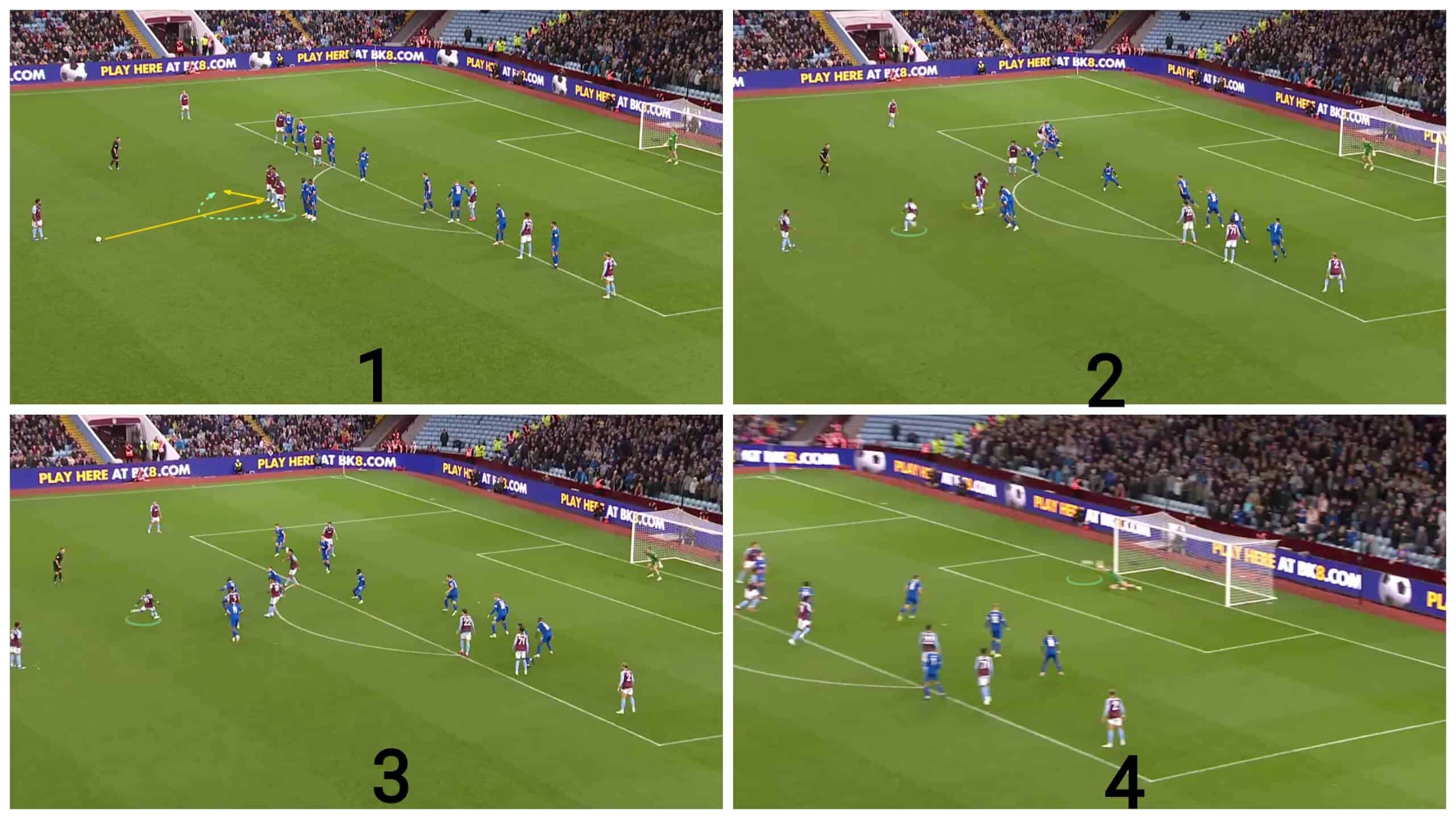
In the case below, the free-kick is wider and presents too tricky a task for the taker to shoot directly. A simple pass is played to his teammate, who just touches it to make it stop in a very good position. The resulting shot is impressive.
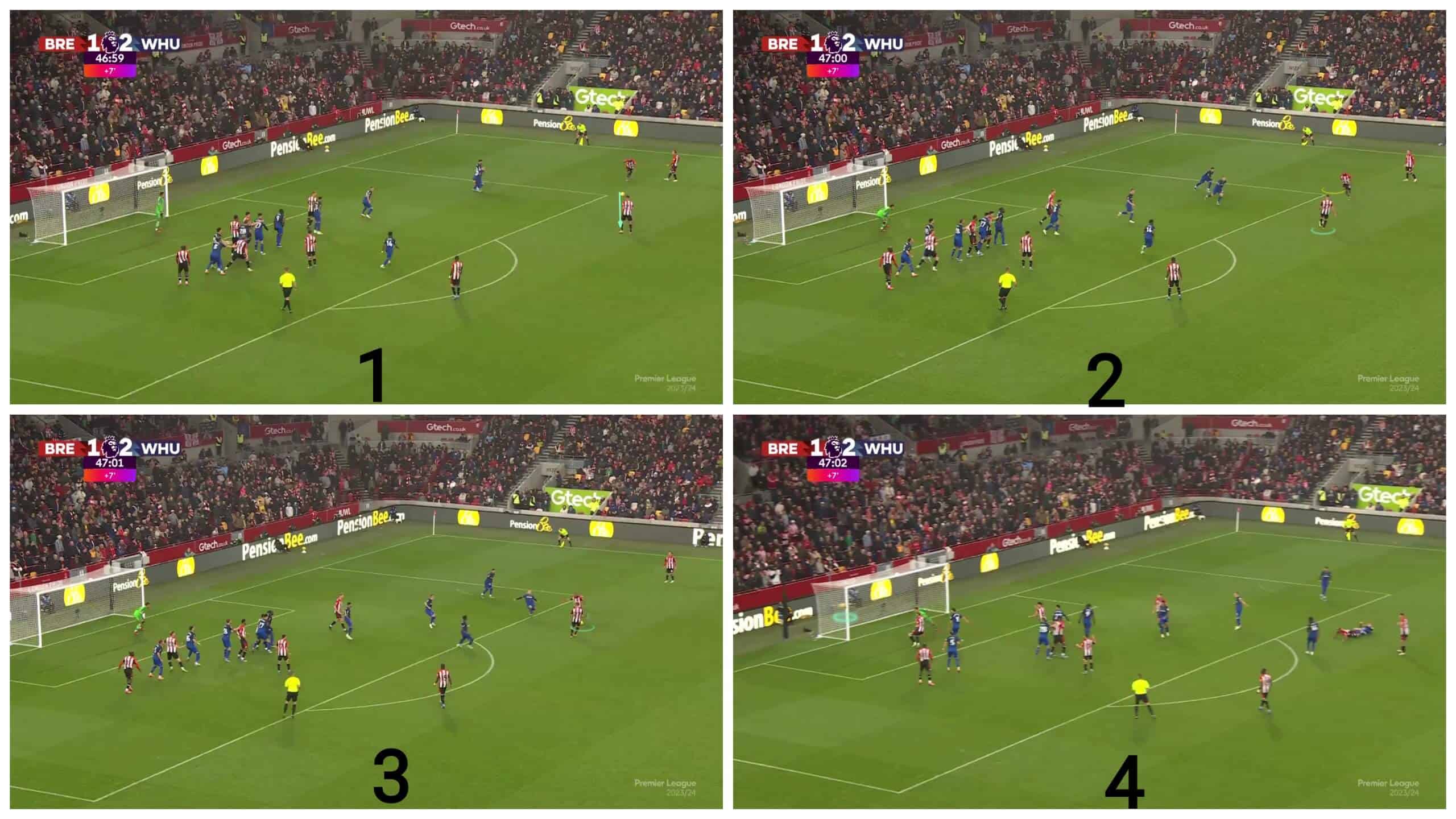
In the case below, this foul is a direct free-kick, so Chelsea put many defenders as a wall. Villa exploited the ample spaces left, transforming it into an indirect free-kick via a small trick.
They asked a player in the attacking wall to suddenly block the defender on the left and make it easier for the attacker to send the cross from inside the box.
In the third and fourth photos, the second part of the plan is to ask two players to go on the near and far posts; one starts in an offside position while the other one comes from deep without the annoyance of the defenders.
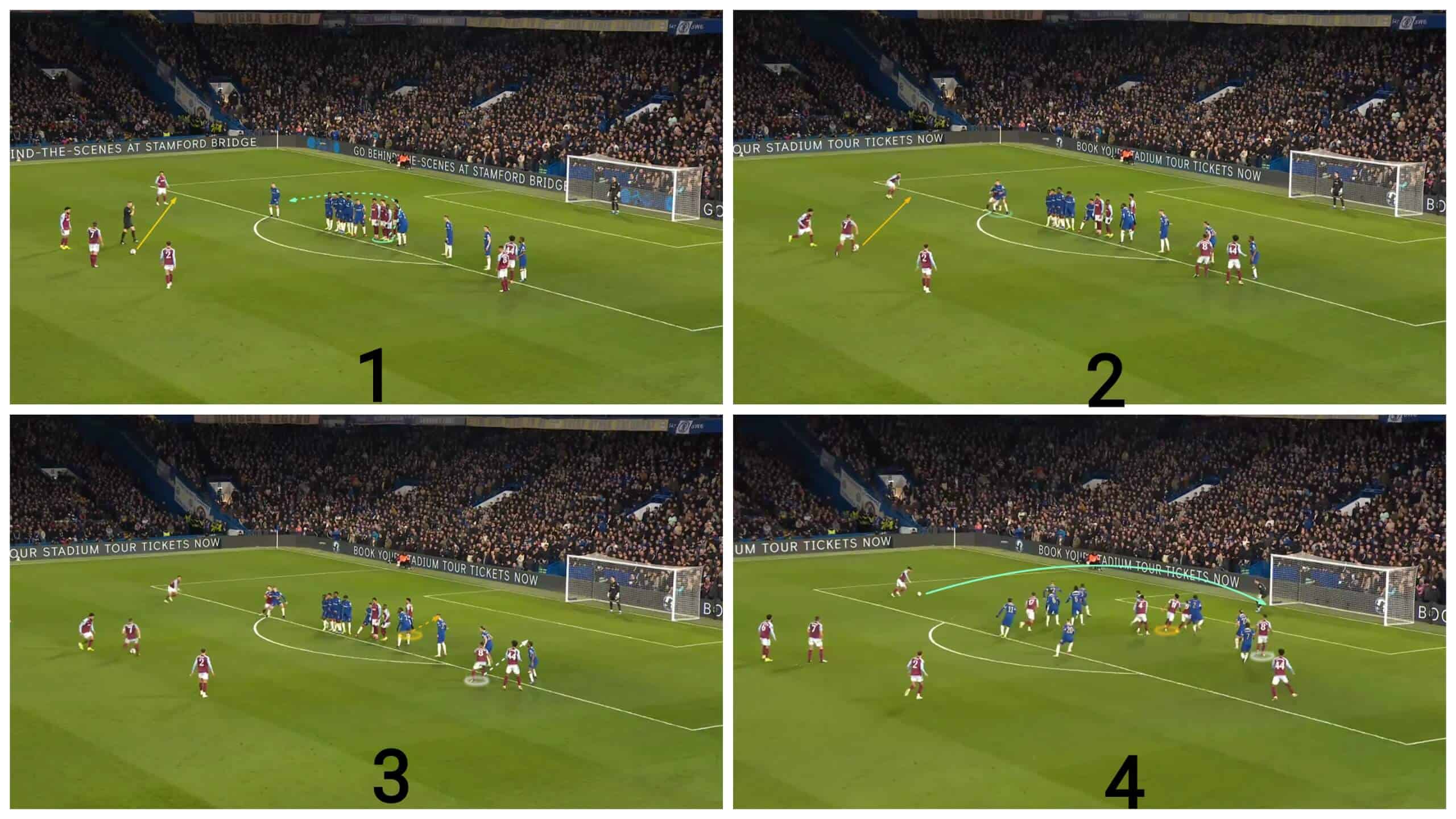
This results in a dangerous header.
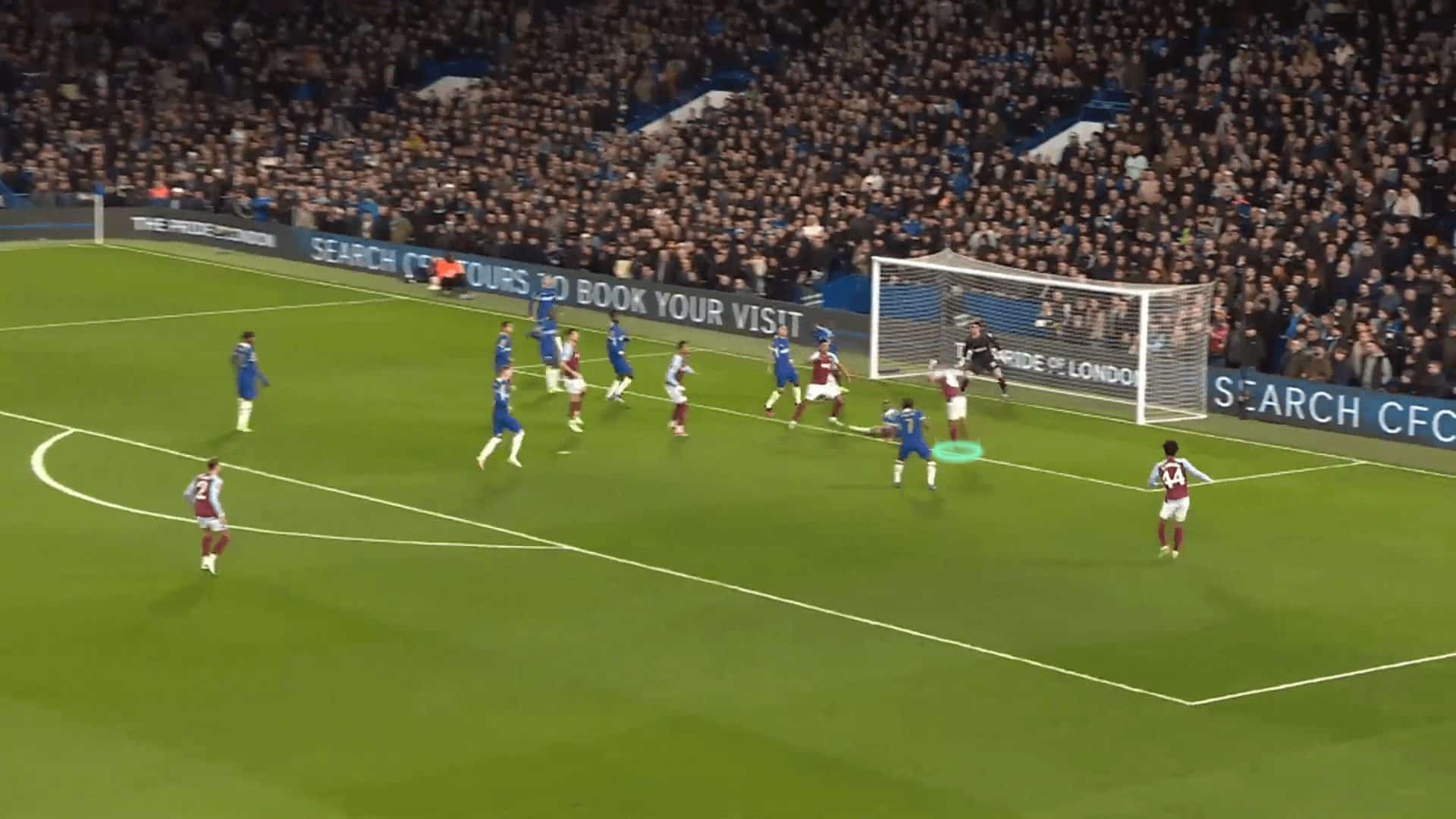
One-v-one situation
In open-play phases, many teams aim for wing rotations using patterns between the full-back, the winger and the midfielder just to put their skilful winger in a 1v1 — so easy from free-kick situations. Thus, many teams exploit the defensive retreat and the formation of a defensive line to protect the goalmouth, subsequently delivering a sudden short pass to the skilful winger in a close 1v1 near the goal.
The case below shows this idea, so the attacking team exploits a central free-kick, asking two players in green to stand wide, fixing the defenders to provide a space for the attackers in yellow. In the second photo, one receives a sudden pass while a teammate blocks the defender to give him more time on the ball to go near the box. This ends with a 1v1 on the edge of the box.
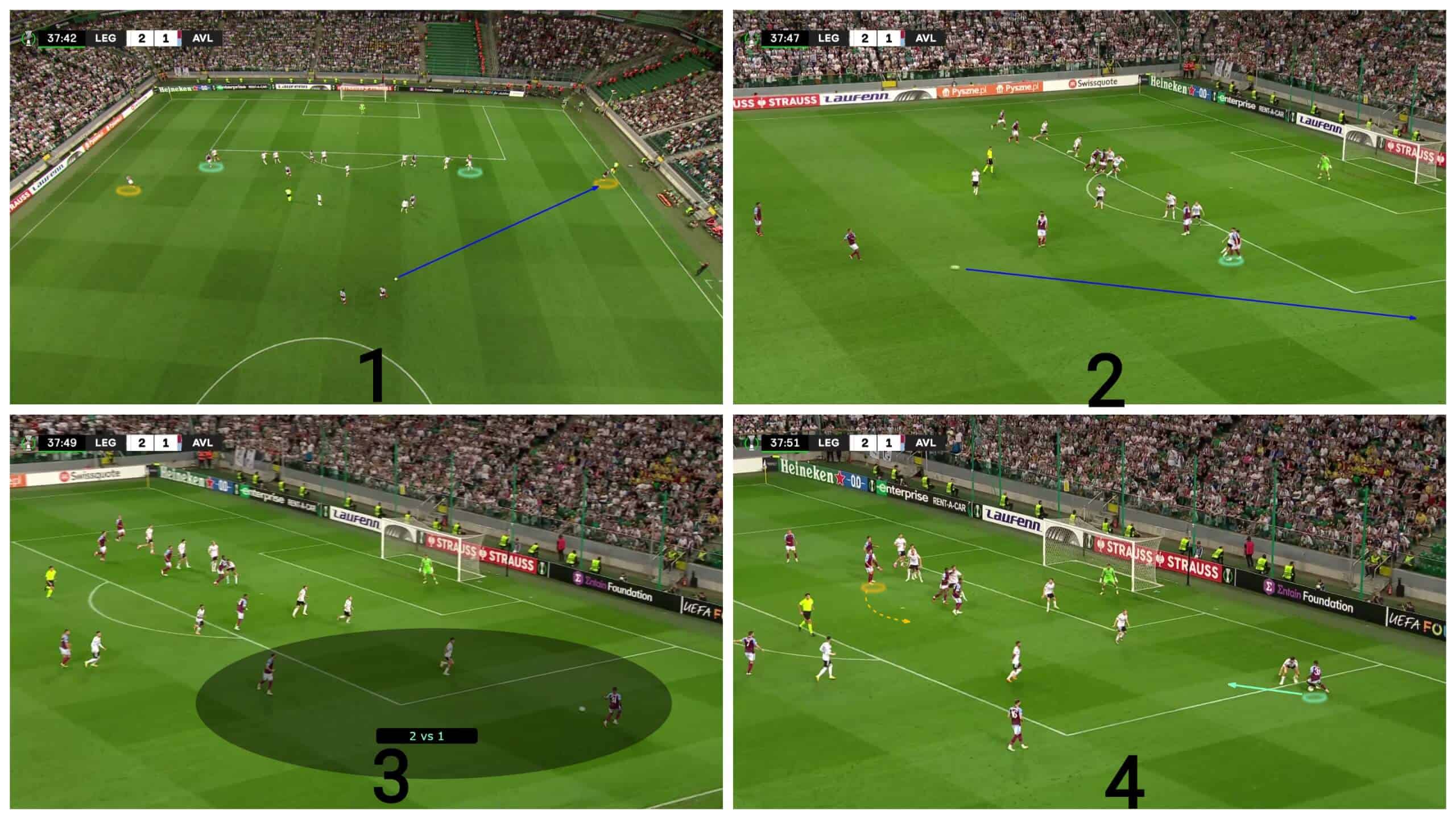
The winger skillfully dribbles inside to send a cross, but a defender intercepts well, as shown in the following photos.
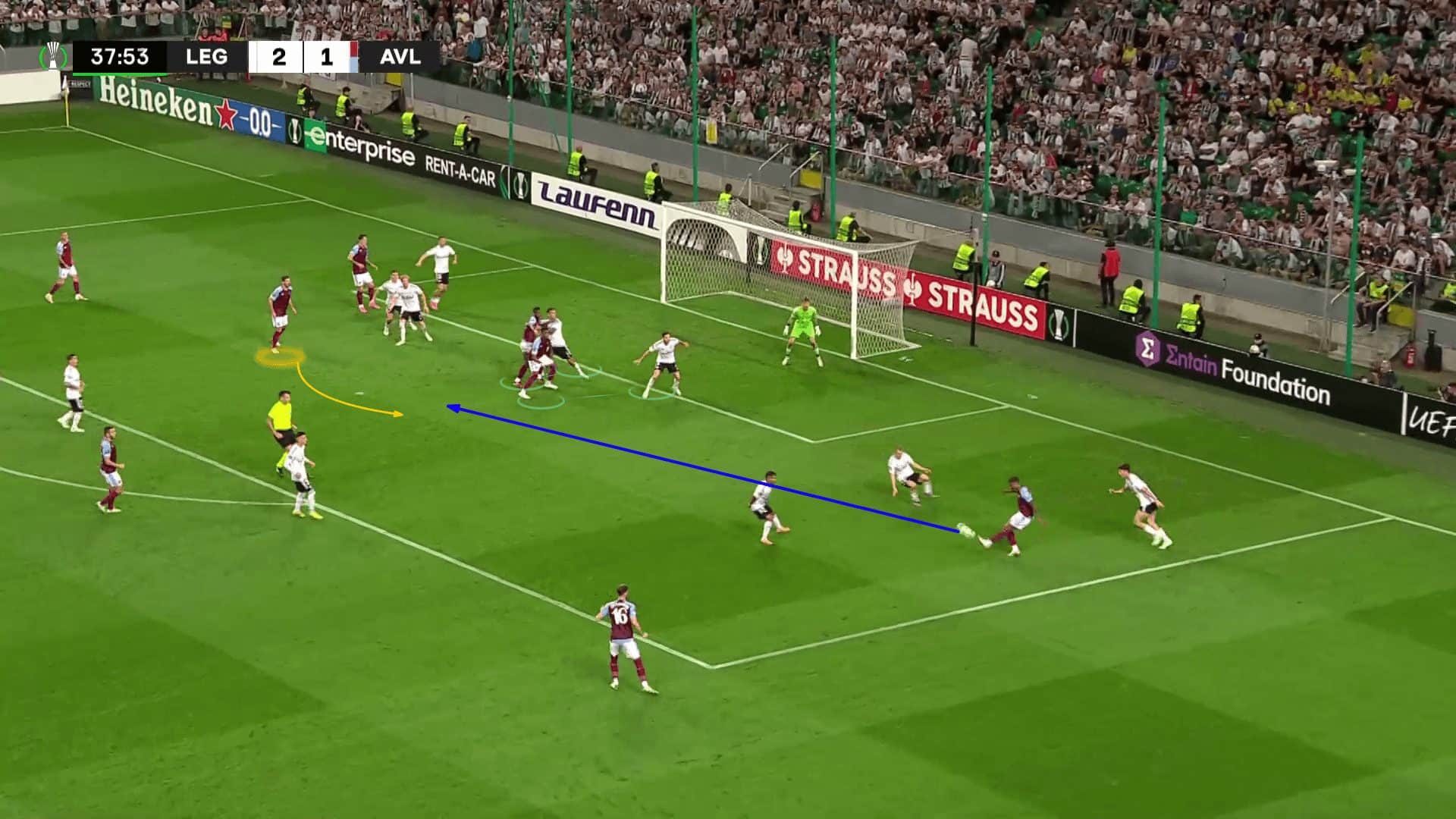
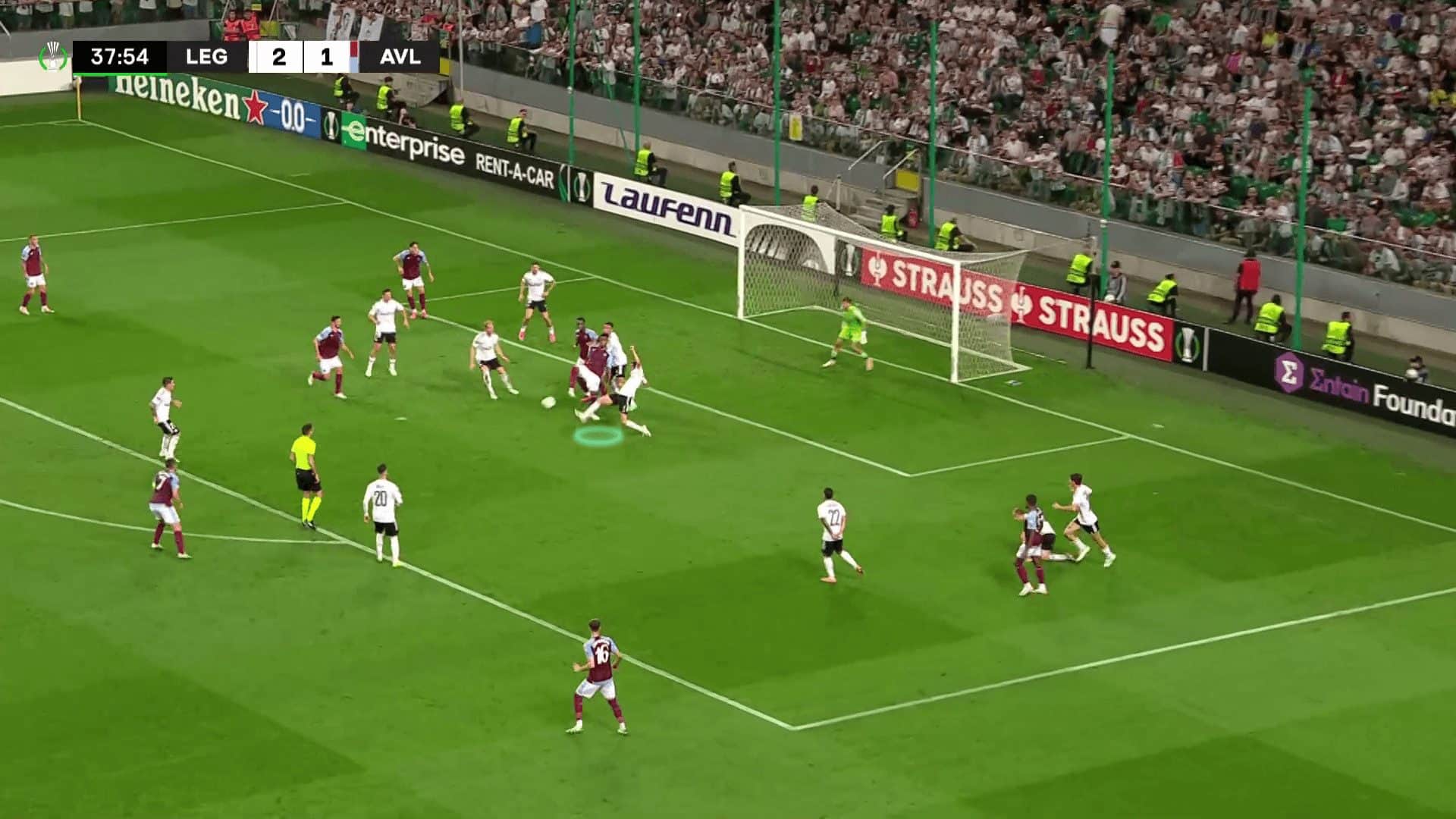
The area behind the wall
One of the areas that many defending teams need to improve is giving more importance to the far post, especially when the attacking team overloads this region, dragging the line a little toward it without asking a player to defend the area.
Man City follow the same strategy below by overloading the far post and asking the second attacker, in green, to move in the area behind the ball. In contrast, the first attacker, in yellow, fixes the first defender, preventing him from going to this area.
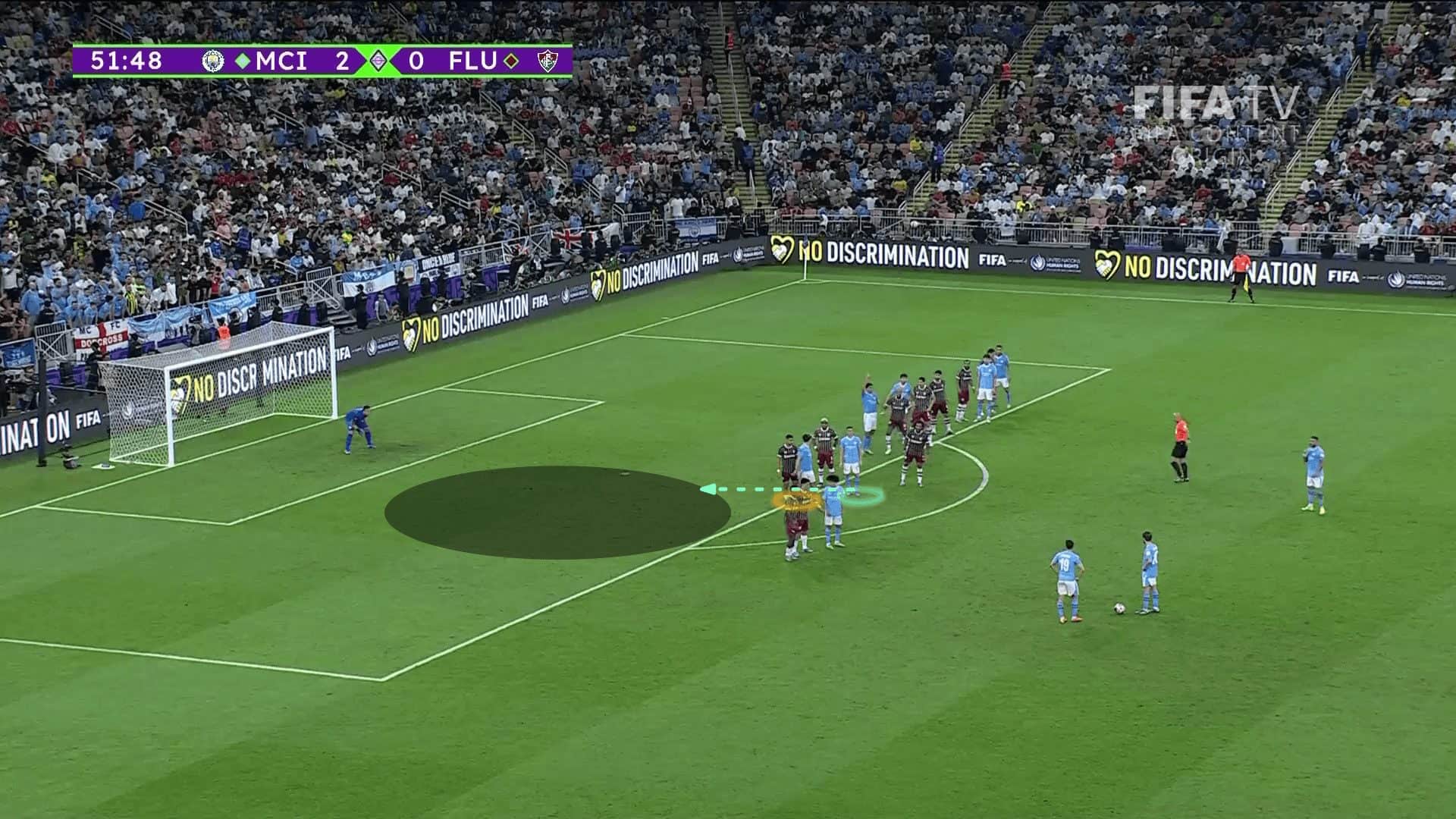
In the first photo below, after the second taker touches the ball, three offside players move to the far post to receive the cross, as shown in the second and third photos, but the goalkeeper deals with the cross, as shown in the fourth photo.
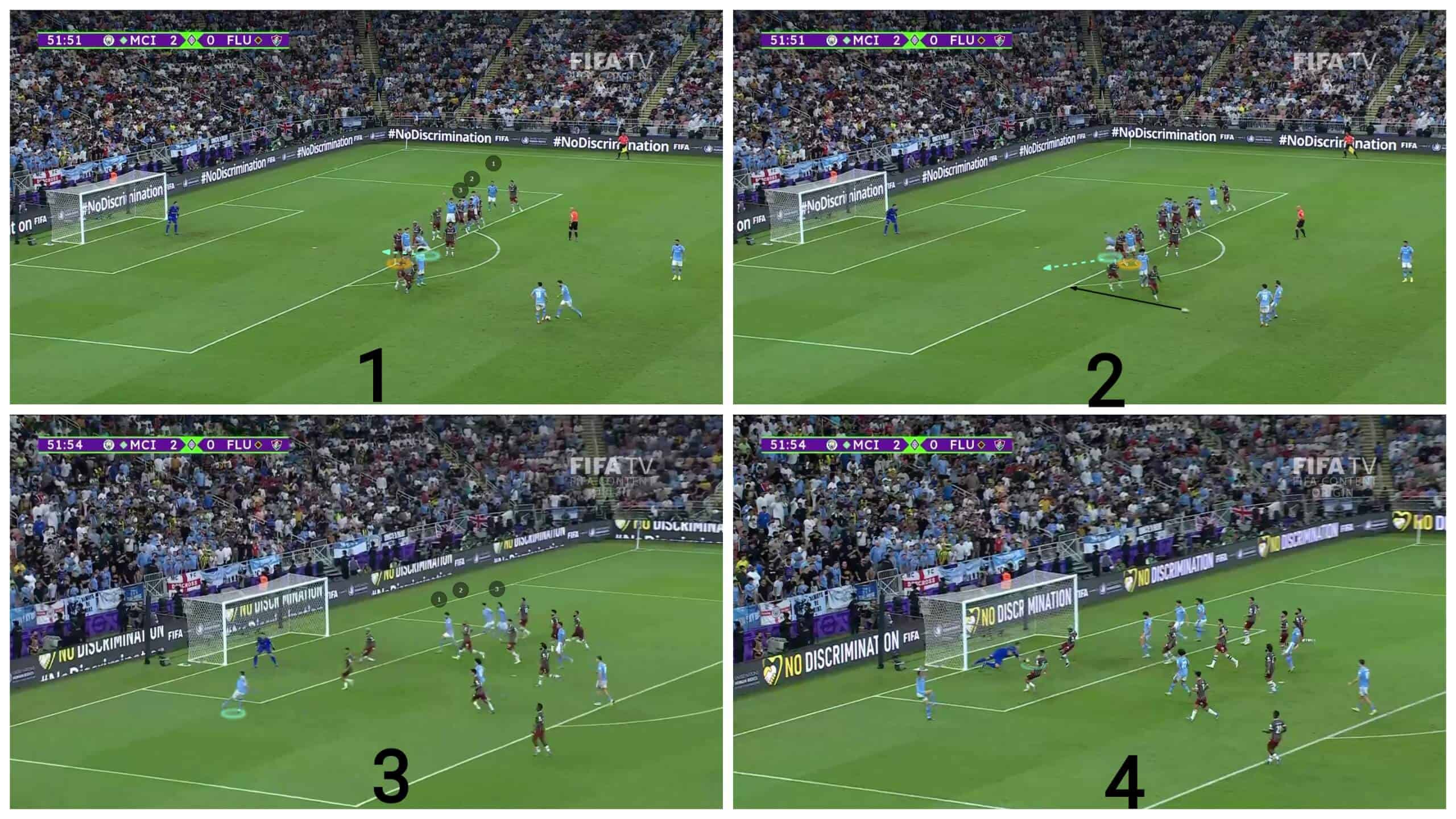
Arsenal use the same strategy in the case below, but with a different routine by asking four players to stand initially in an offside position. The green player is the target for the pass, while the other three block the first three defenders in the line. Here, we should mention that Liverpool put a player on the left, but he is dragged wider by an Arsenal attacker to open this passing lane.
In the second photo, an offside attacker moves towards the far post to receive the cross, the second part of the plan, with one of the first three offside players dropping to get onto the end of the cut-back.
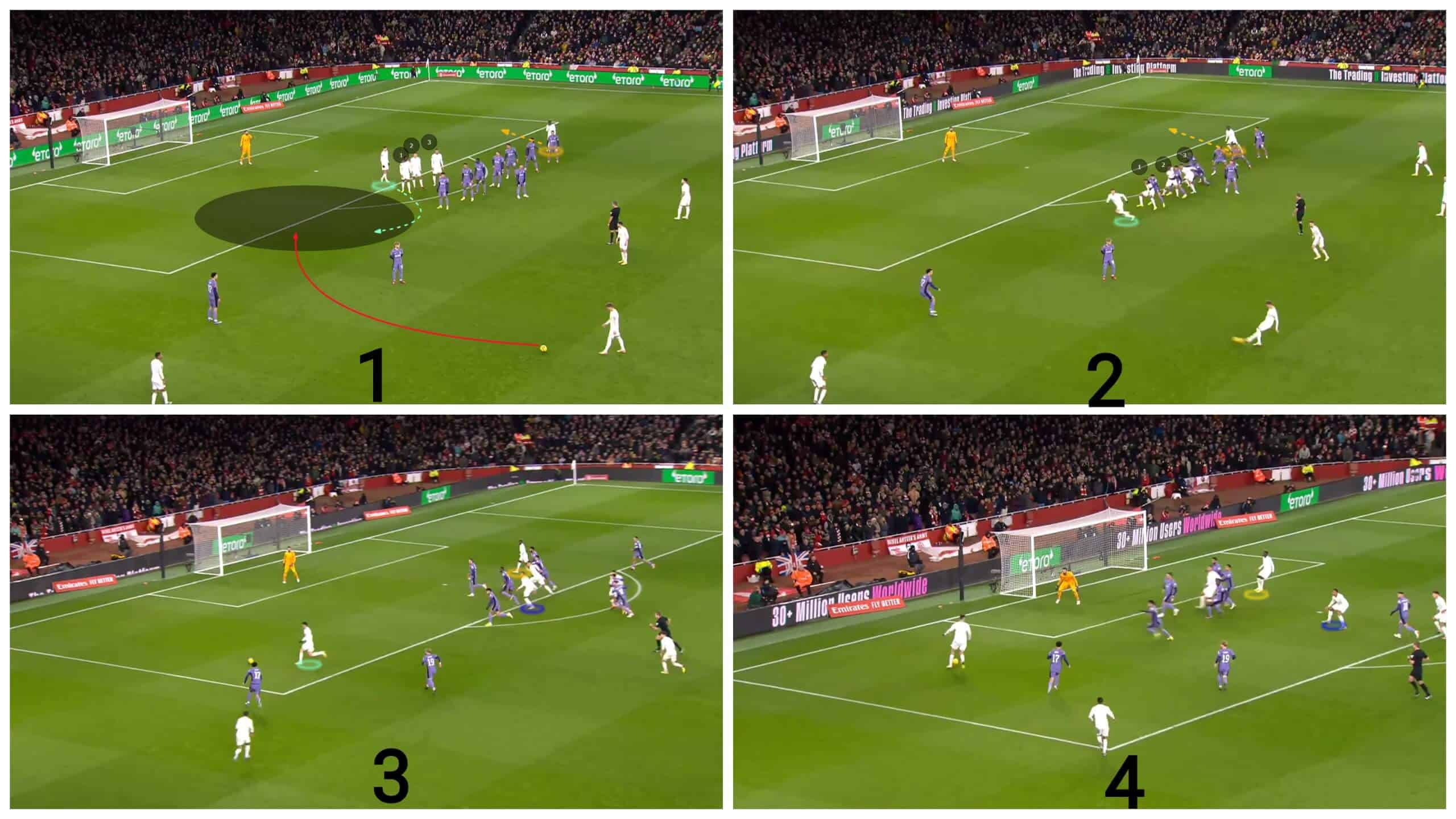
This produces a very desirable result, shown below.
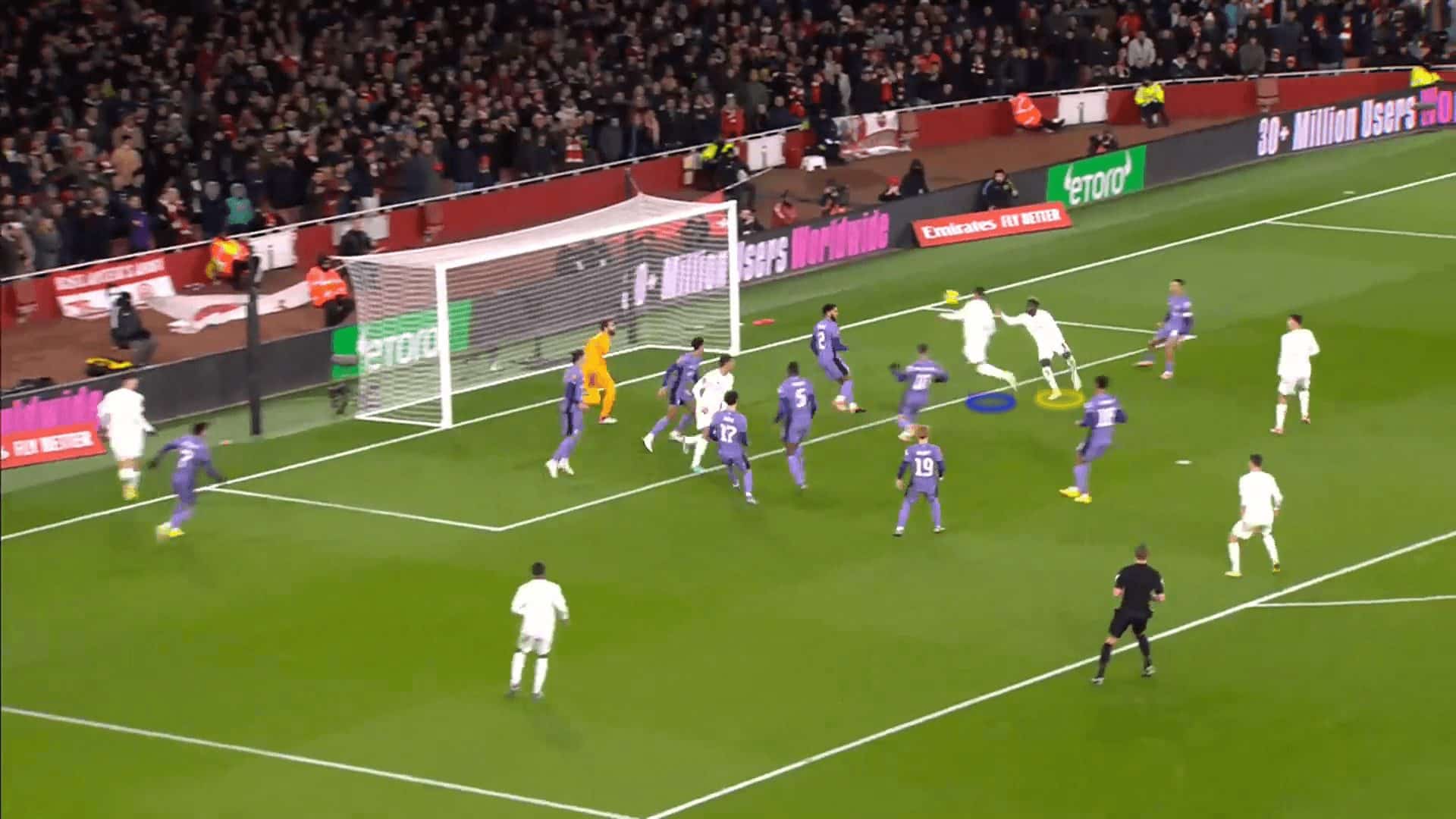
Man City used this strategy against Burnley, who were better prepared to receive a cross against Man City’s overload at the far post. As a result, they didn’t use a wall, thinking it was too challenging to shoot from this distance. Kevin De Bruyne passed it directly to Julián Álvarez, who acted as a rebound player, then moved suddenly behind the rebound defender, as shown below.
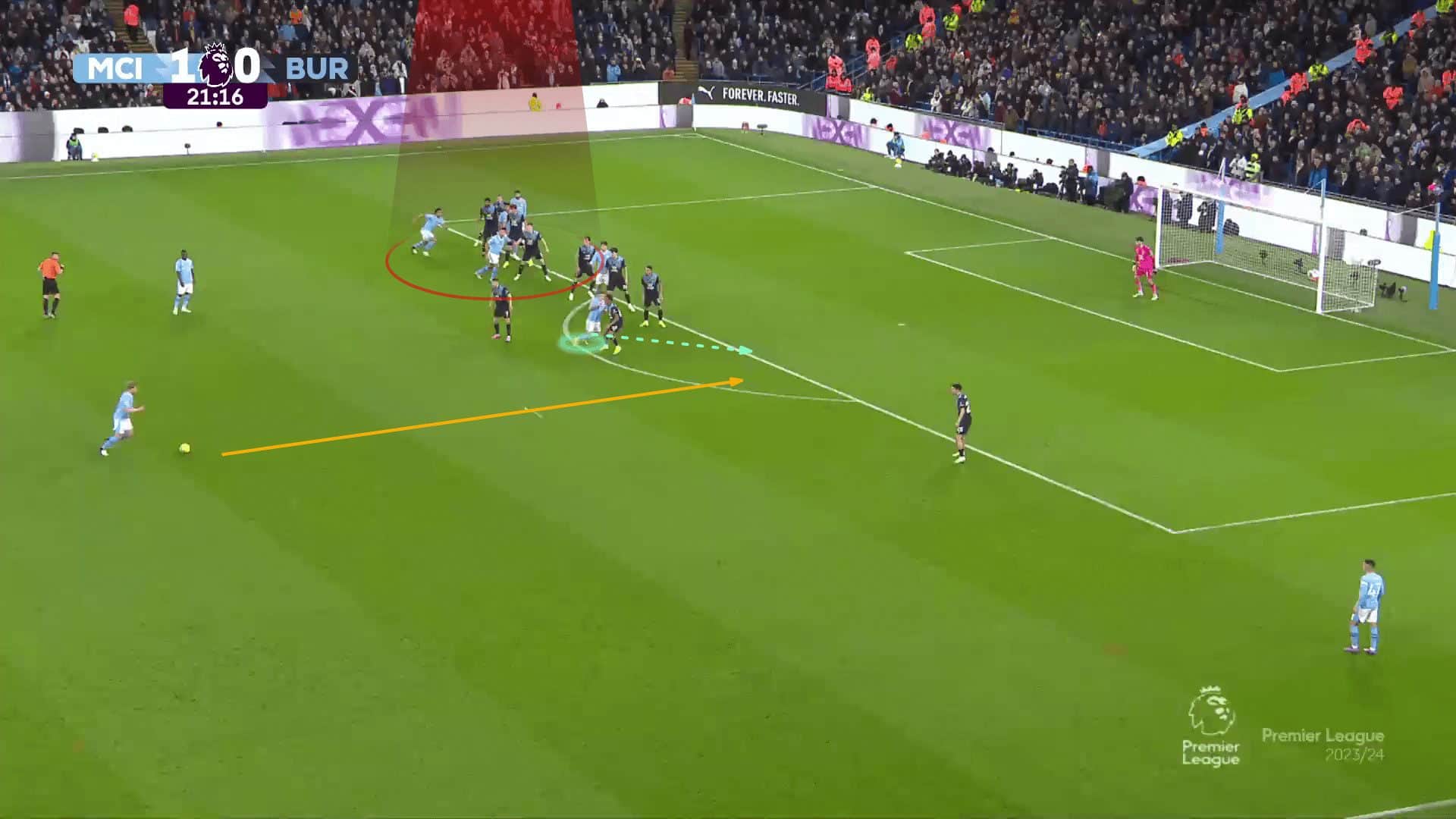
Álvarez scored to finish off this attack. We should also mention the importance of the attacker who stretches the pitch on the right to drag a defender who may go to cut this passing lane.
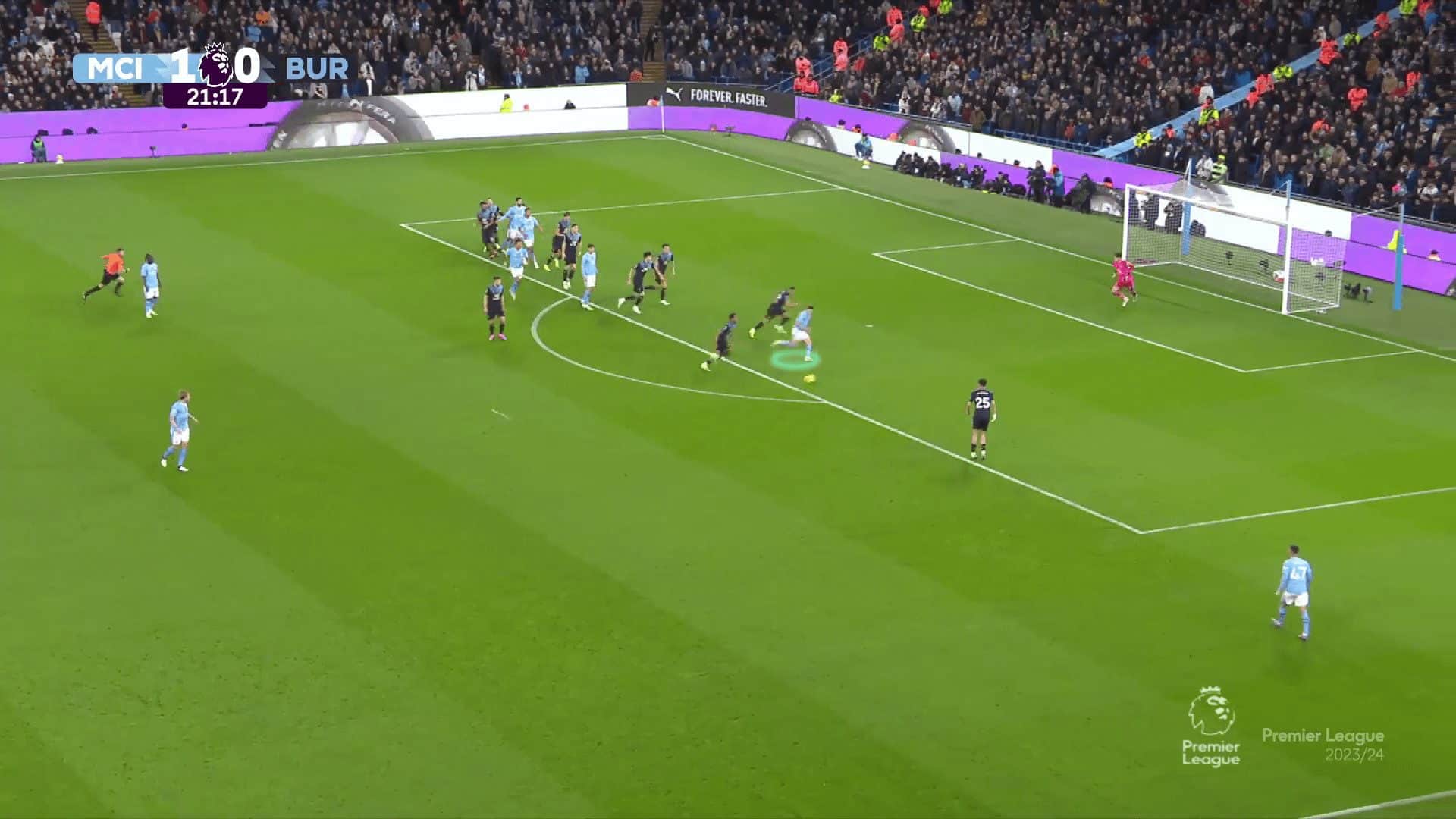
Deep runs to the far post
Now, we come to how to use short passes before sending crosses like normal indirect free-kicks. One of the common purposes is to give time and space for a deep run from a late player who started away from the defenders to target the far post.
By utilising a horizontal pass to a teammate, attackers initiate fake runs in the opposite direction of the intended target, causing chaos in the defensive line and leading to a lack of synchronisation in the offside trap. These movements, coupled with ball movement, distract defenders from the targeted area, compelling them to focus on tracking their teammates to maintain defensive alignment while simultaneously monitoring the ball and opposing players who move in the opposite direction of the ball. Let’s clarify this with an example.
In the photo below, the taker passes the ball to his teammate. In contrast, some attackers run in the opposite direction of the pass and the targeted player on the far post. At the same time, the defensive line is organised with some defenders covering behind, so the targeted player has the time and the space to run without fearing from the offside. The second taker, in yellow, moves to the near post to be ready for the next cross or headed pass.
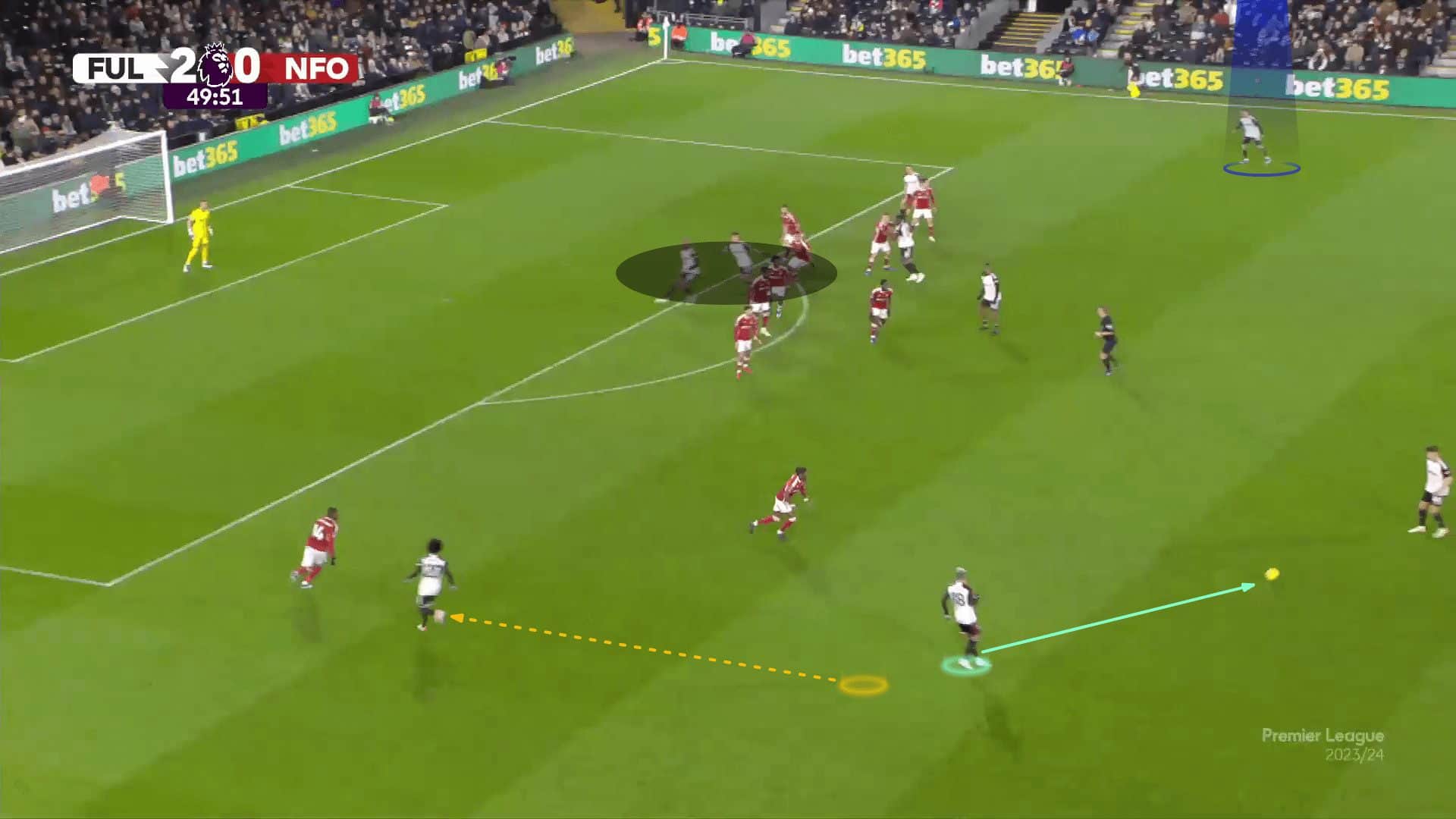
In the photo below, a green-highlighted player blocks the last defender, preventing him from following the cross, while a red offside player waits in the middle for a cross or a headed pass.
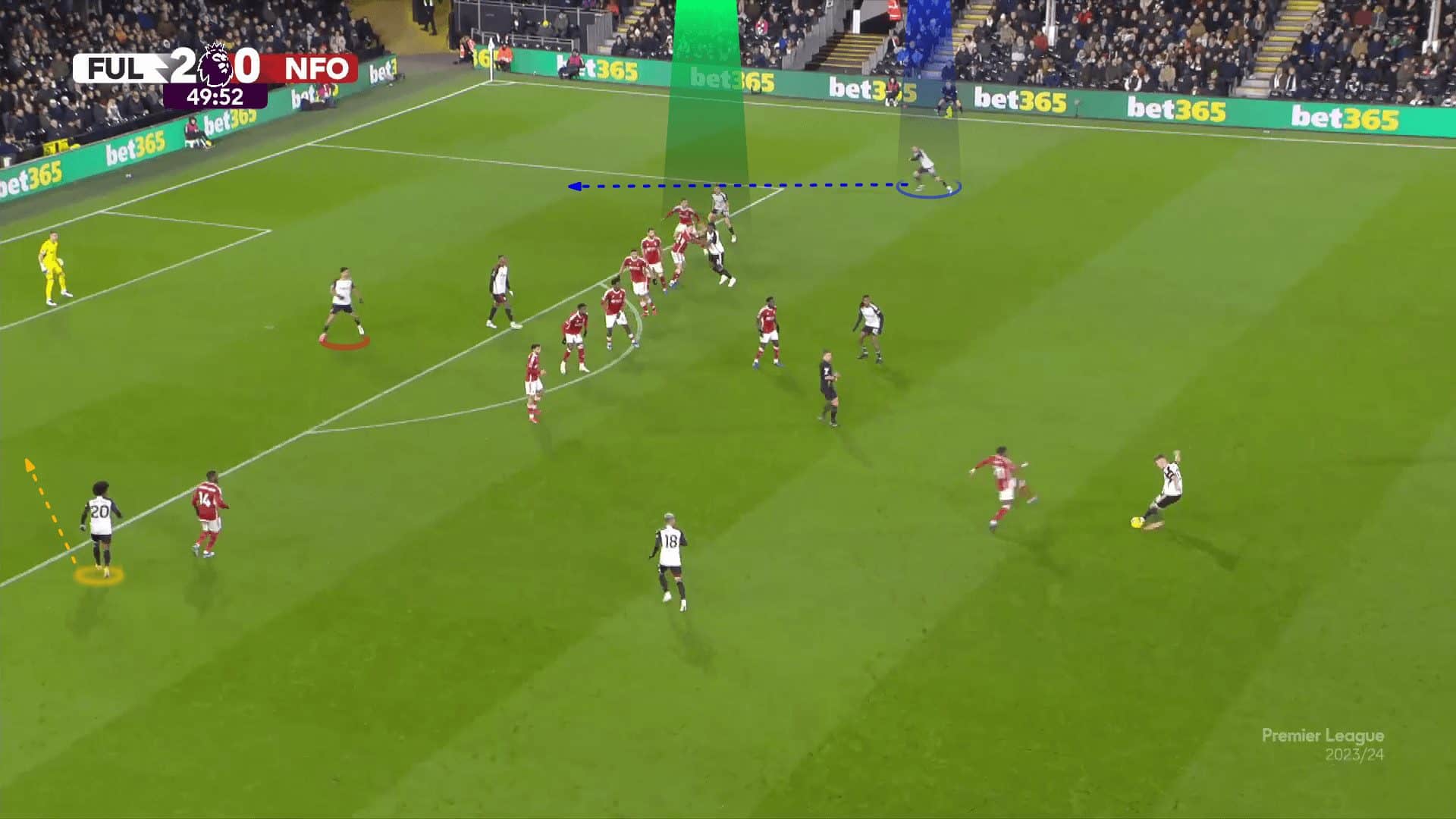
But the cross is heavy, so the targeted player almost controls the ball, as shown below.
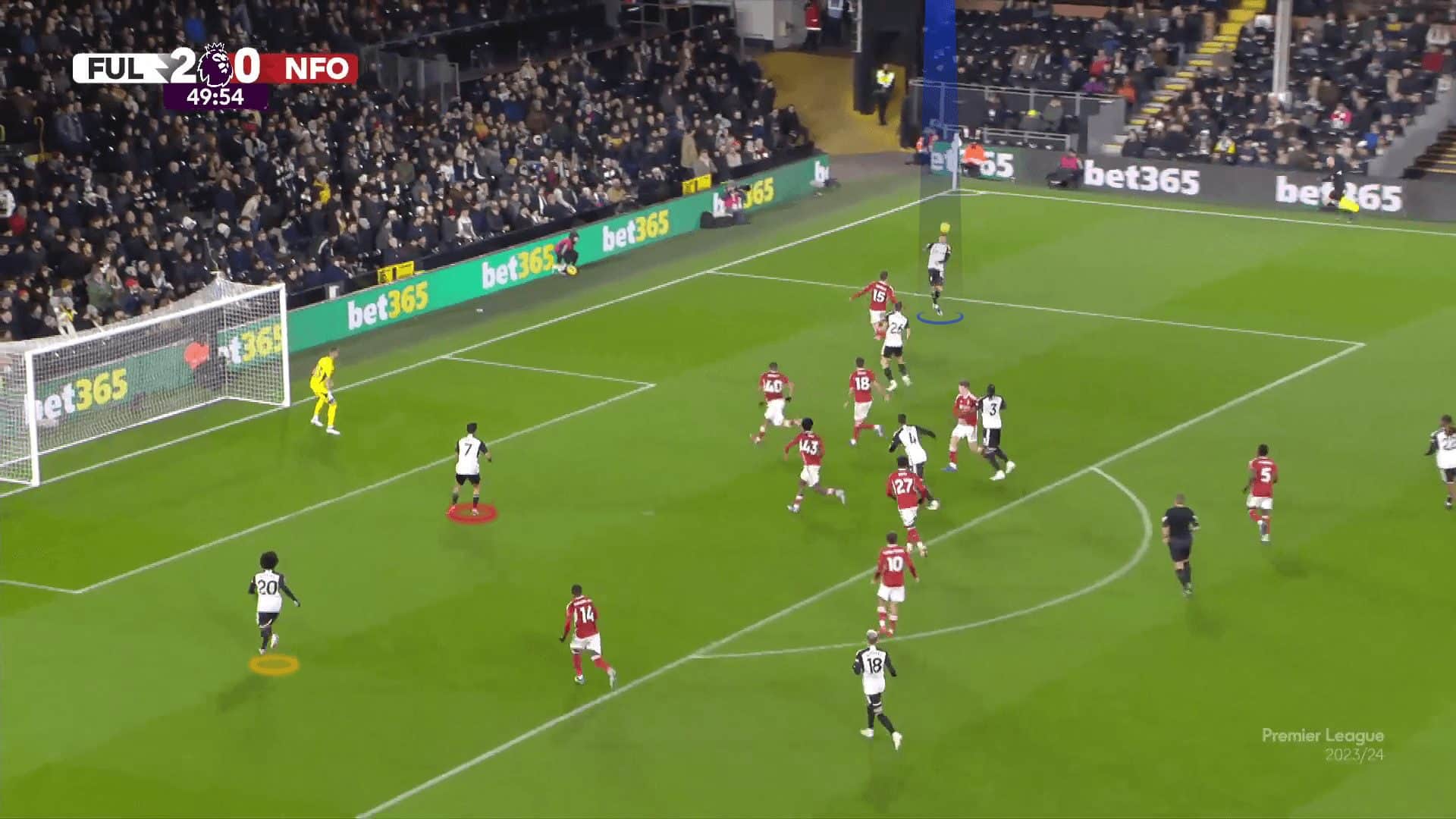
Make it at a better point
Some teams use some short rotations to play the ball from a better position, so you can imagine the difference between a free-kick from point 1 and point 2, as shown below.
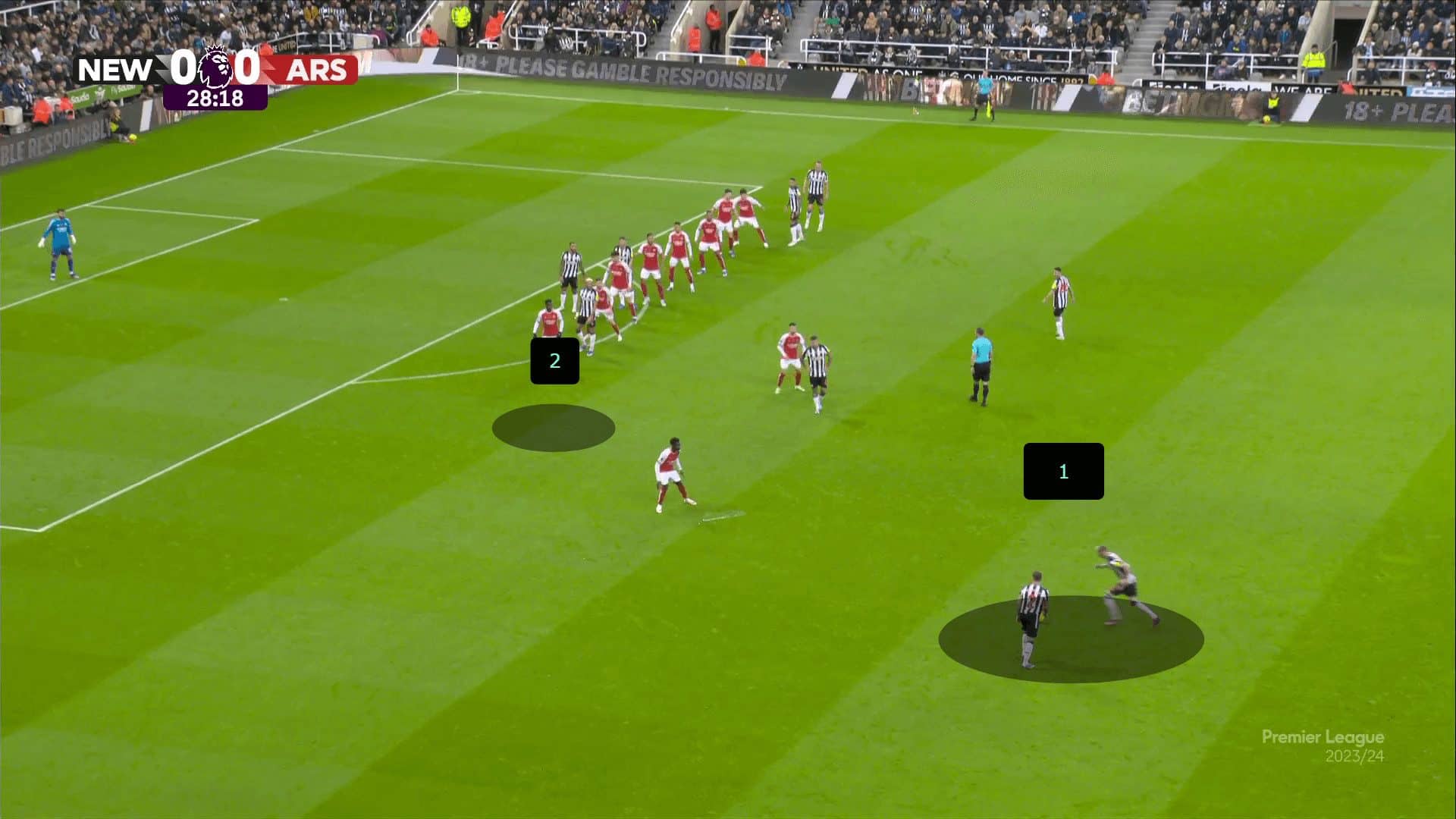
In the first photo below, the second taker touches the ball, and some passes are completed to reach the new position and send the cross to the far post behind the last defender who focuses on the ball movement, as in the third photo. In the fourth, the attacker can get the ball while his teammate was waiting for the headed pass.
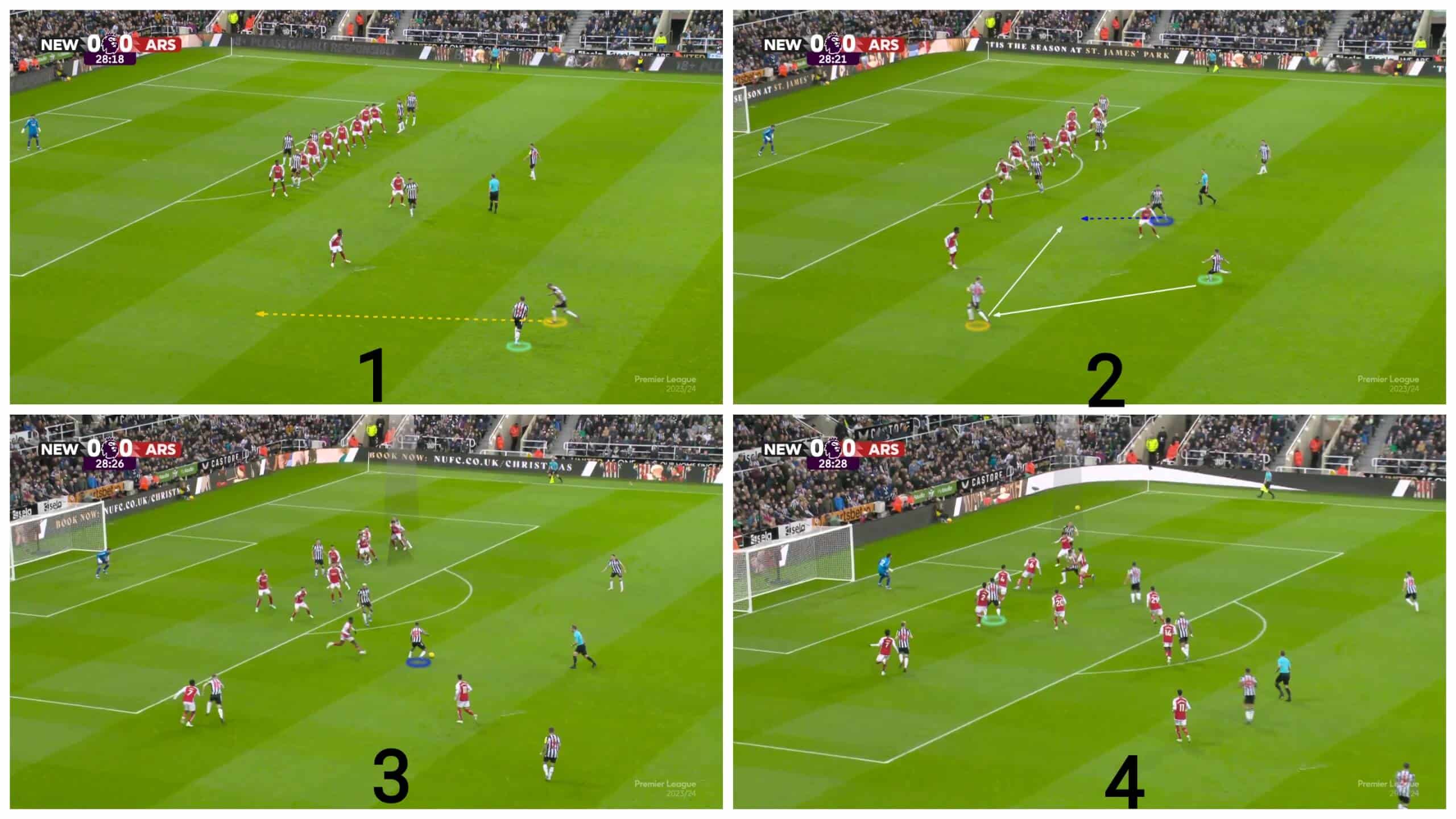
The ball hits a defender and reaches the green attacker in a dangerous situation, but he puts the ball over the crossbar, as shown below.
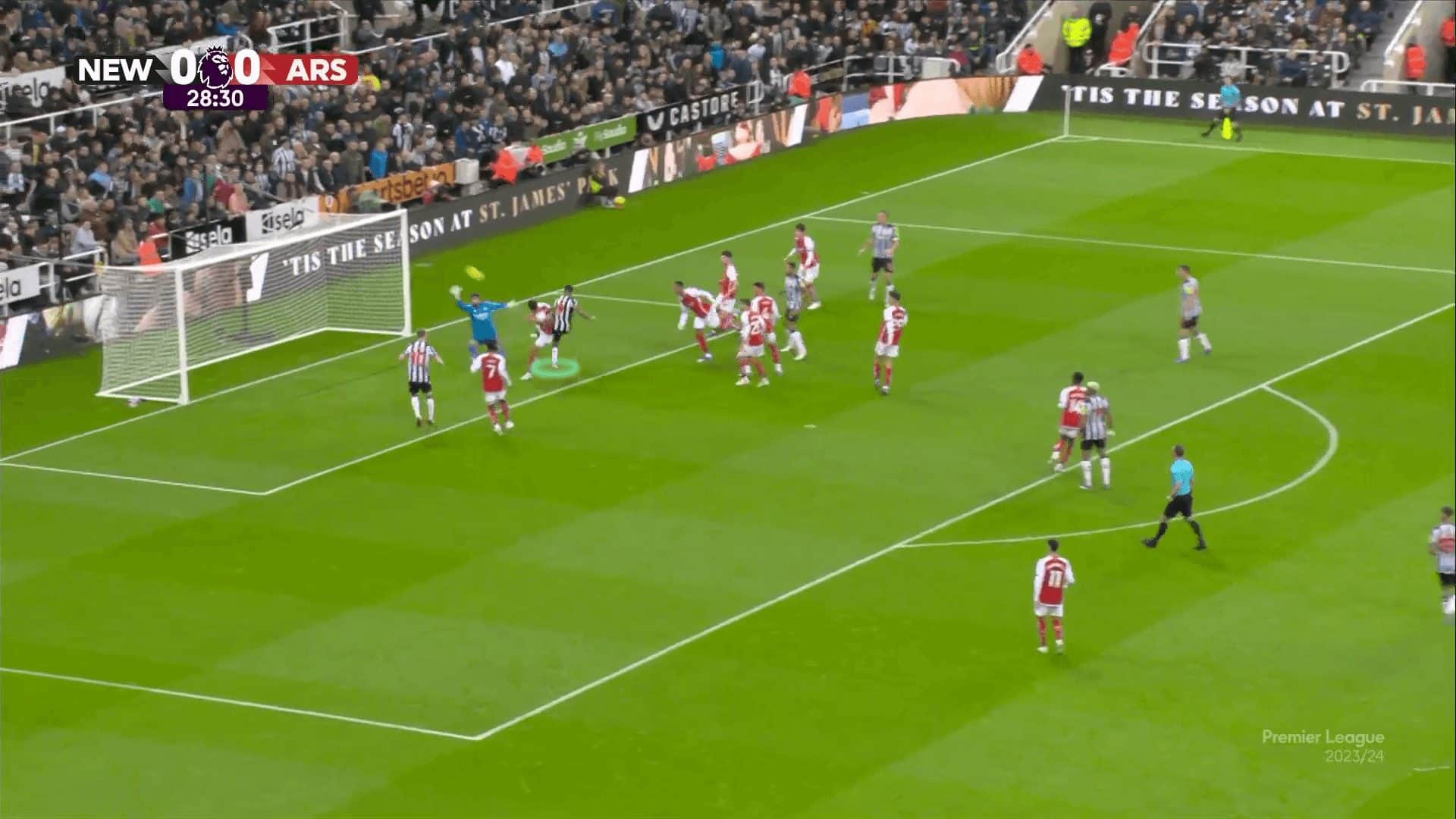
In the case below, Aston Villa have a free-kick in a central position far from goal, which makes it more difficult for the attacker to get onto the end of a cross while running, giving their backs to the ball.
At the same time, the defenders face the ball easily here, and from this kind of position, teams usually don’t send the cross to the middle. Hence, Aston Villa use their numerical superiority in the short area to do some rotations, drag more defenders outside the line and put the ball in a better position.
In the third photo, the last two attackers exploit the fact that the last defender focuses on the ball in the opposite direction to implement a 2v1 and run behind, as in the fourth photo.
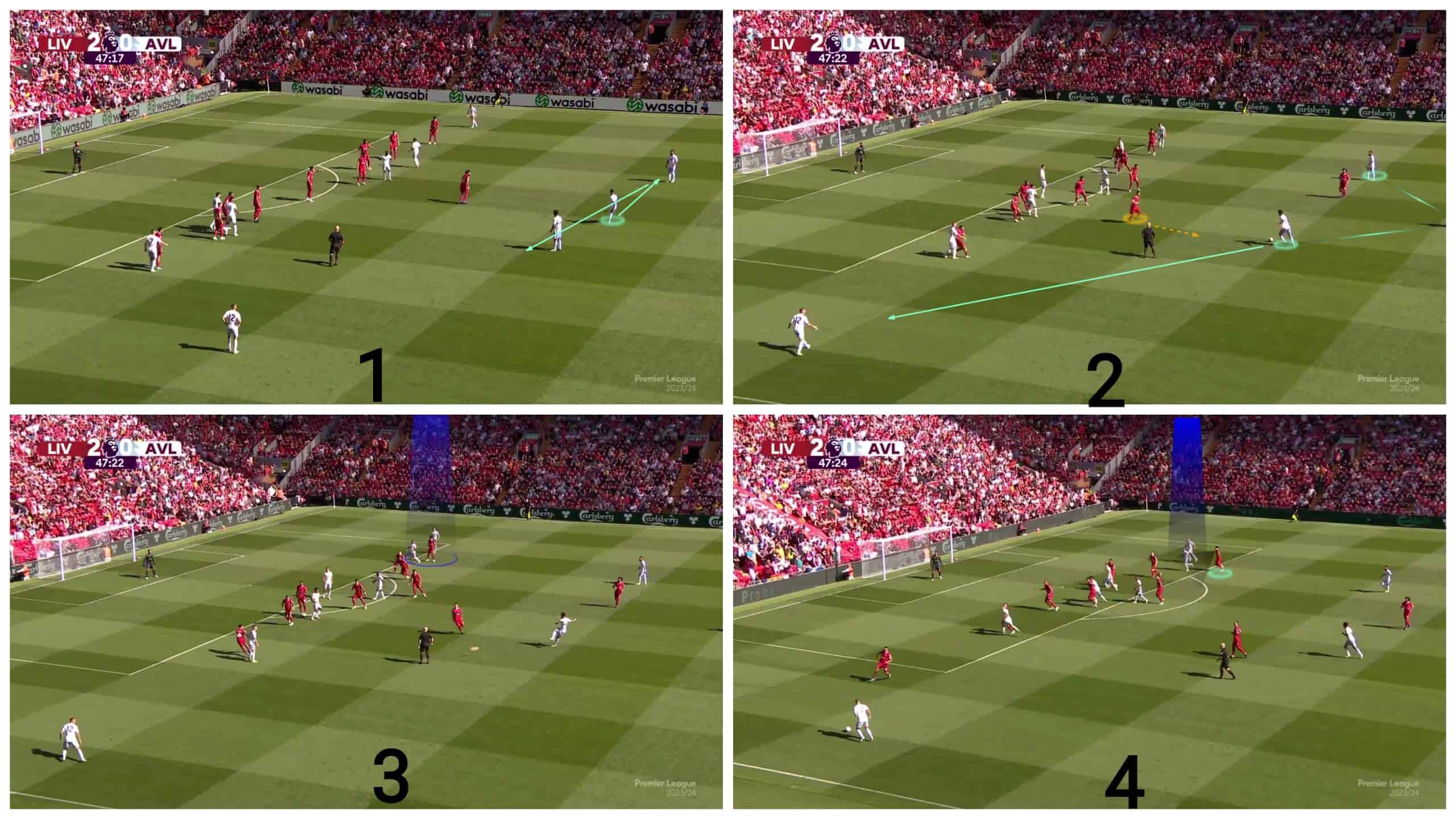
The plan works, but Alisson Becker saves the ball brilliantly, as shown in the two following photos.
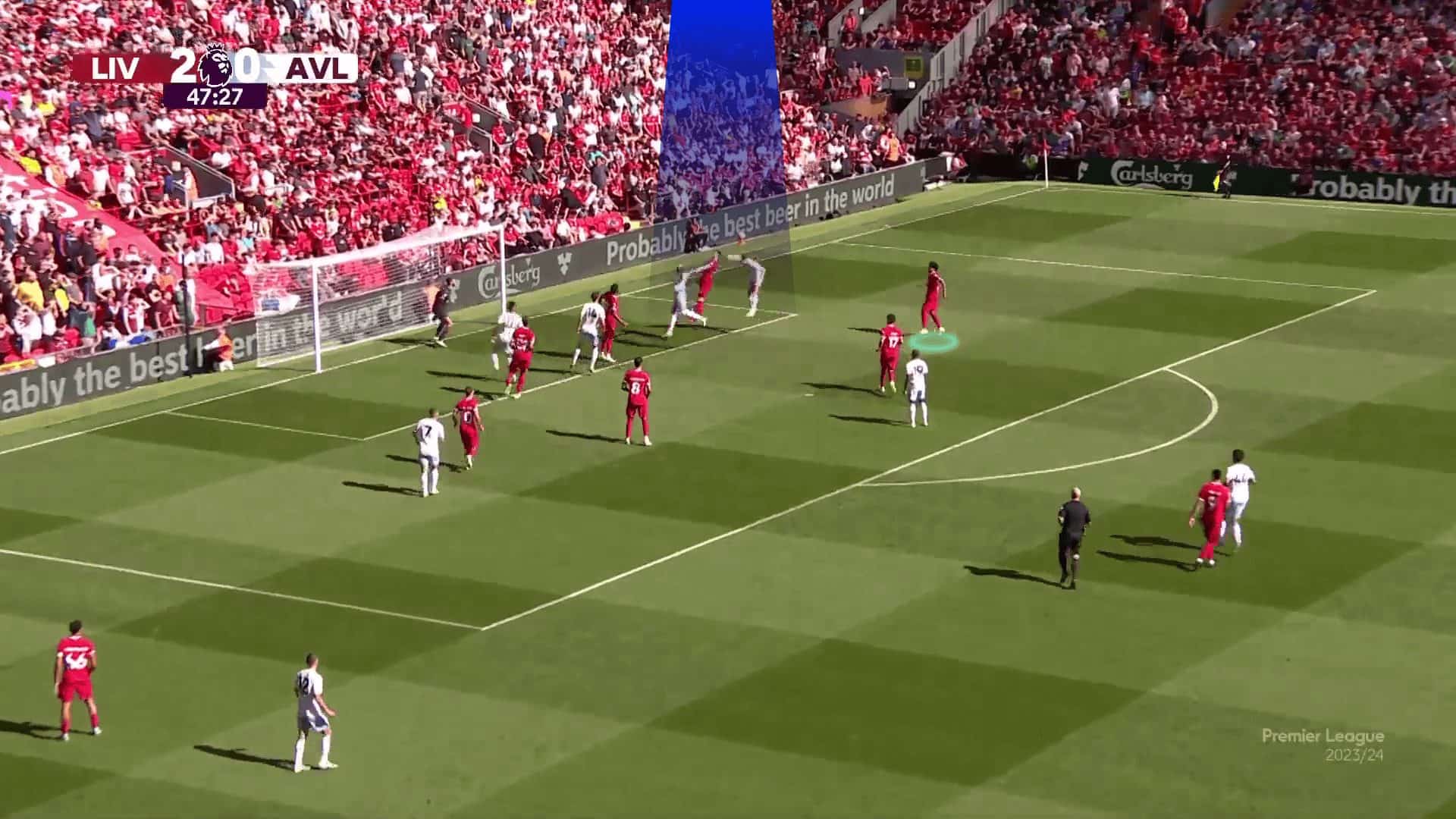
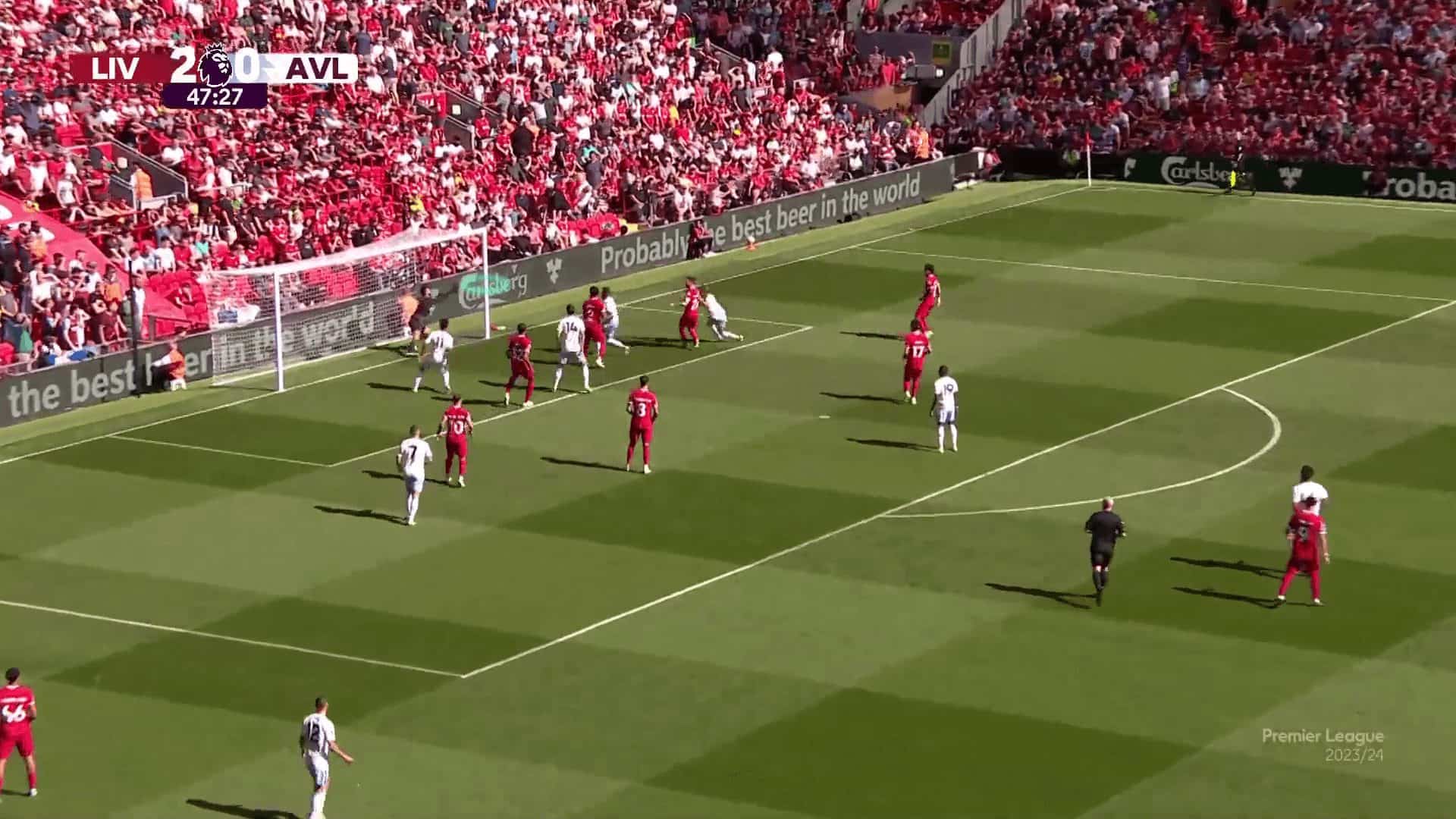
Misdirection
In the first photo below, the defensive line naturally shifts a little towards the far post, leaving the black area less protected because it is not as likely to face a cross here. At the same time, the attacker gives his back to the cross, so Newcastle easily shifted the direction by two passes while a green player moves to the targeted area while these passes, as shown in the second photo.
In the third photo, you can see four attackers in this unprotected area now who are ready for the cross.
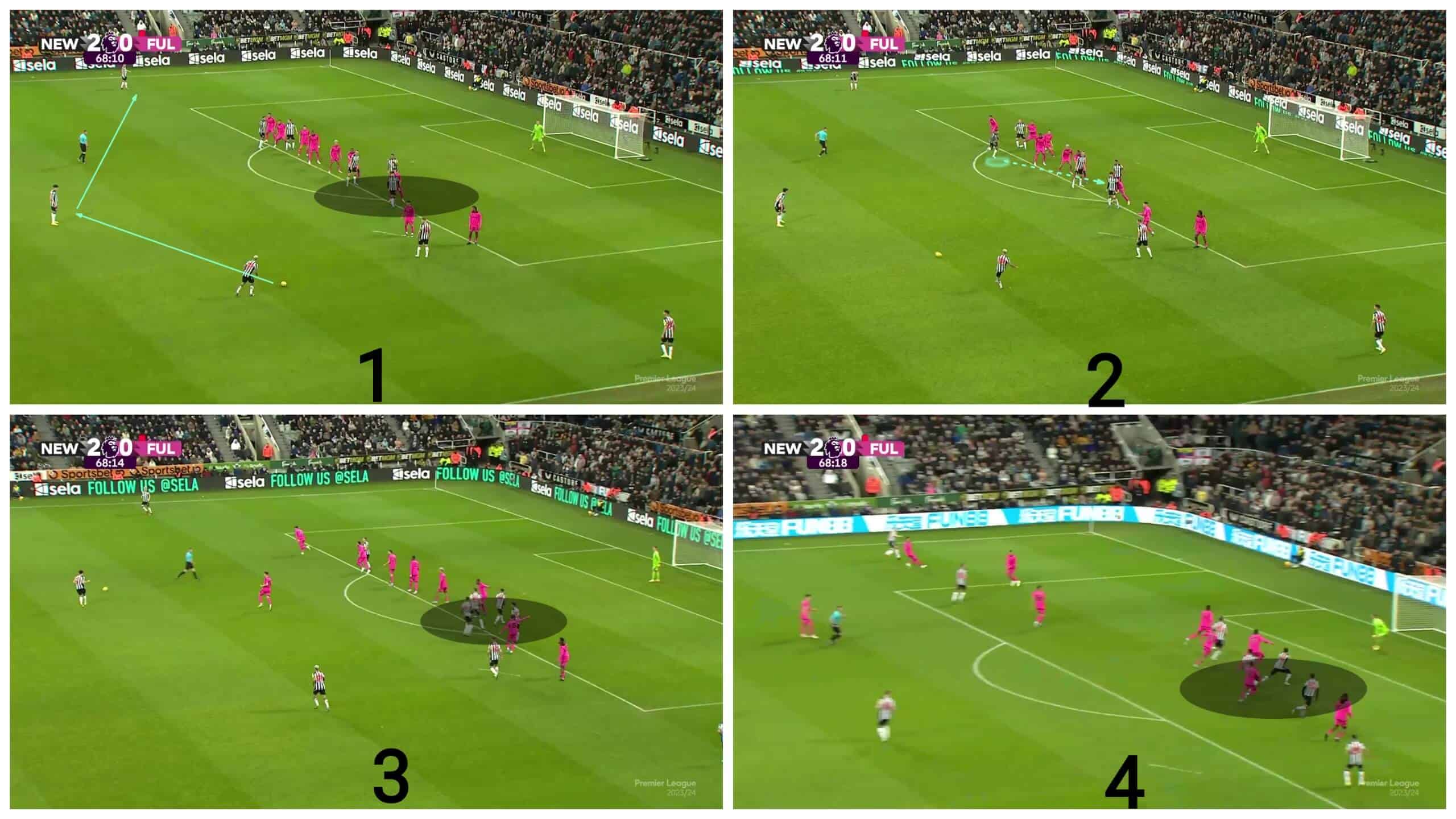
The cross is a little heavy, so the attacker almost receives it.
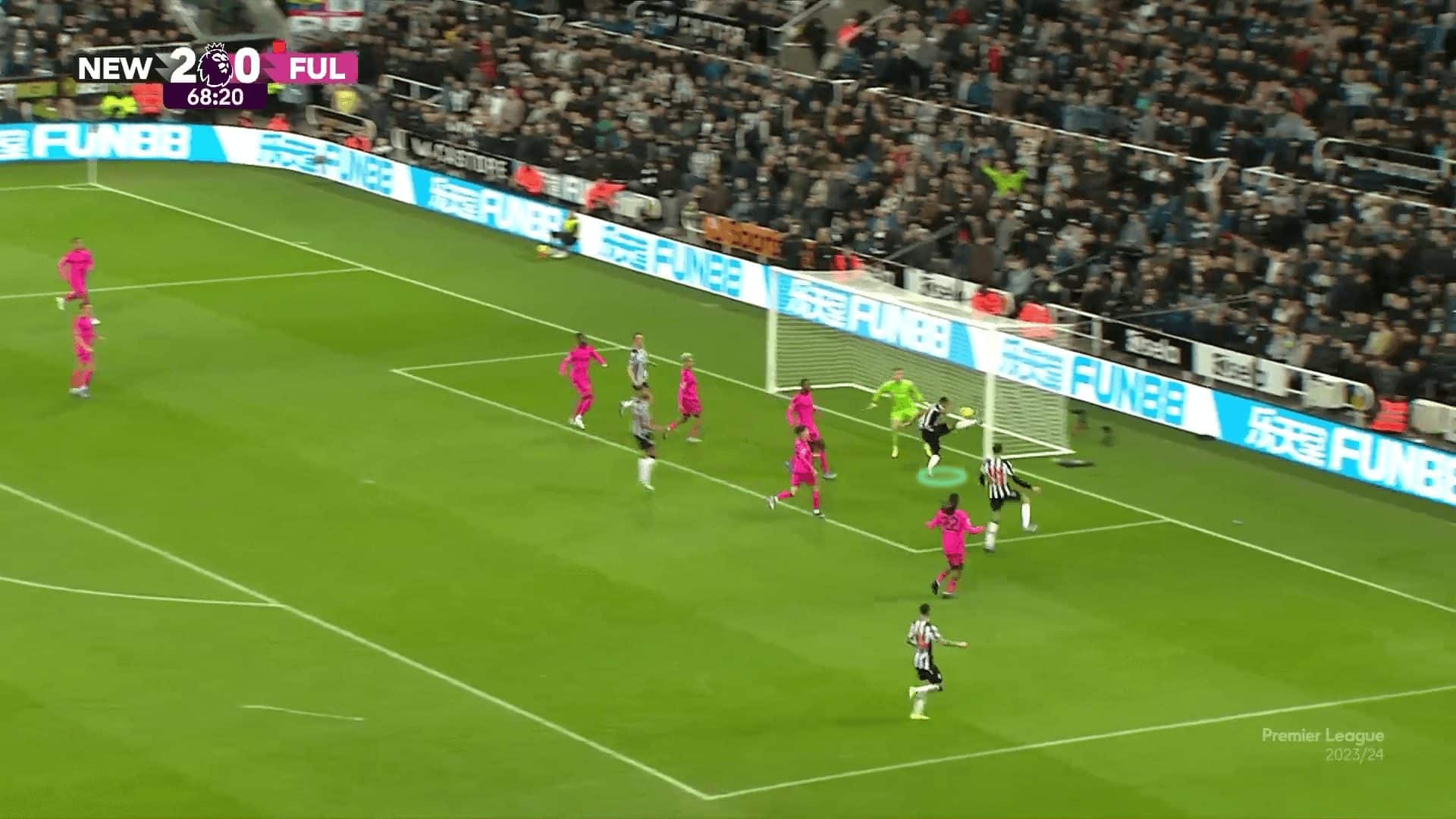
In the first photo below, you can see two offside players in black and blue. One will receive the pass at the end of the routine, while the other will block the last defender.
In the second photo, the green attacker is in an onside position. Still, while his team builds the attack, he exploits the change of all defenders’ body shape to the other position to push his defender from his back to be onside.
At the same time, a teammate in blue blocks the last defender, dragging him a little back and trying to cover the offside for other teammates.
In the fourth photo, we now see attackers going to the targeted area while others are ready for the pass with the help of their initial offside positions.
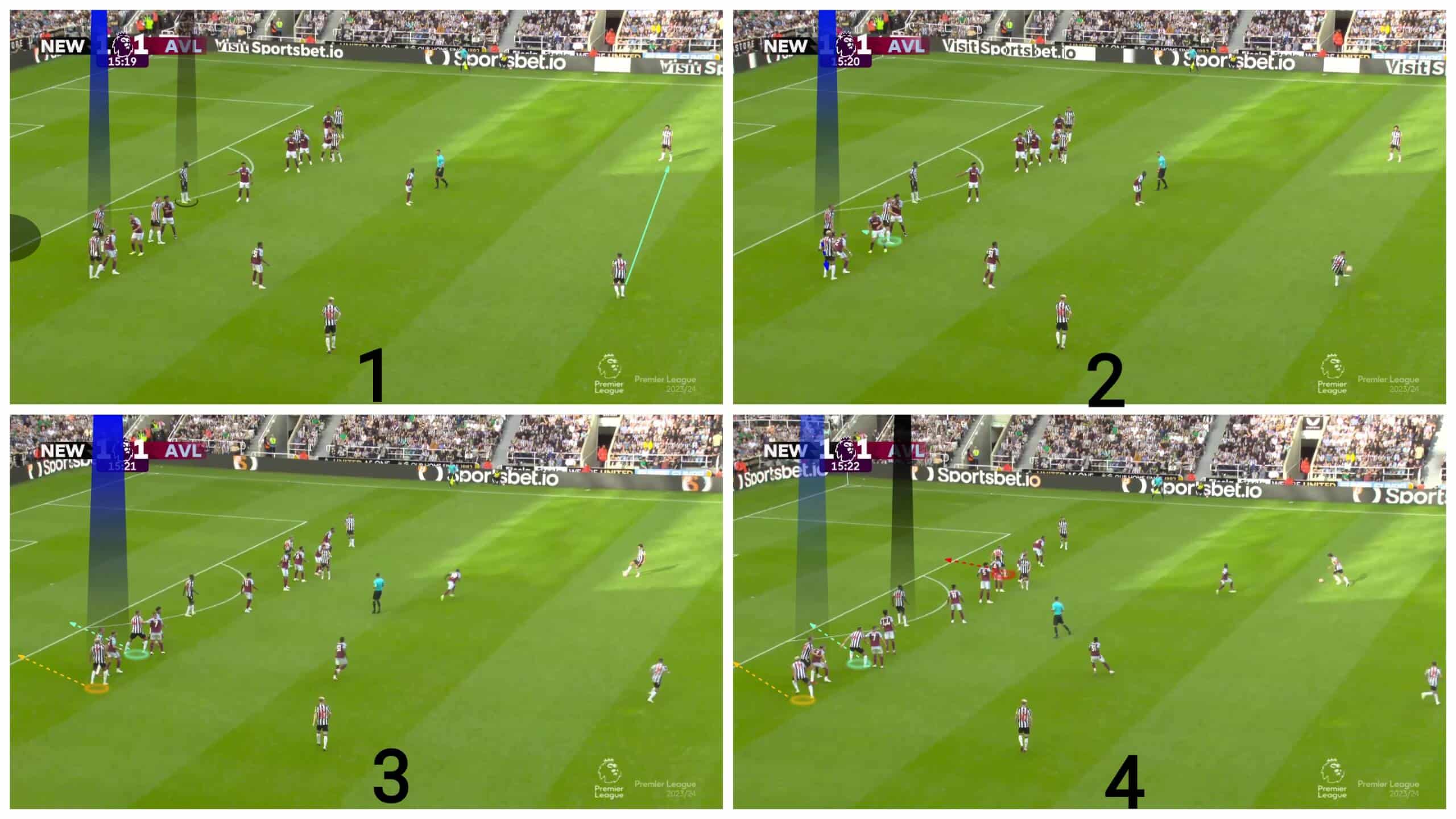
The plan works, and the result is a goal, as shown in the following two photos.
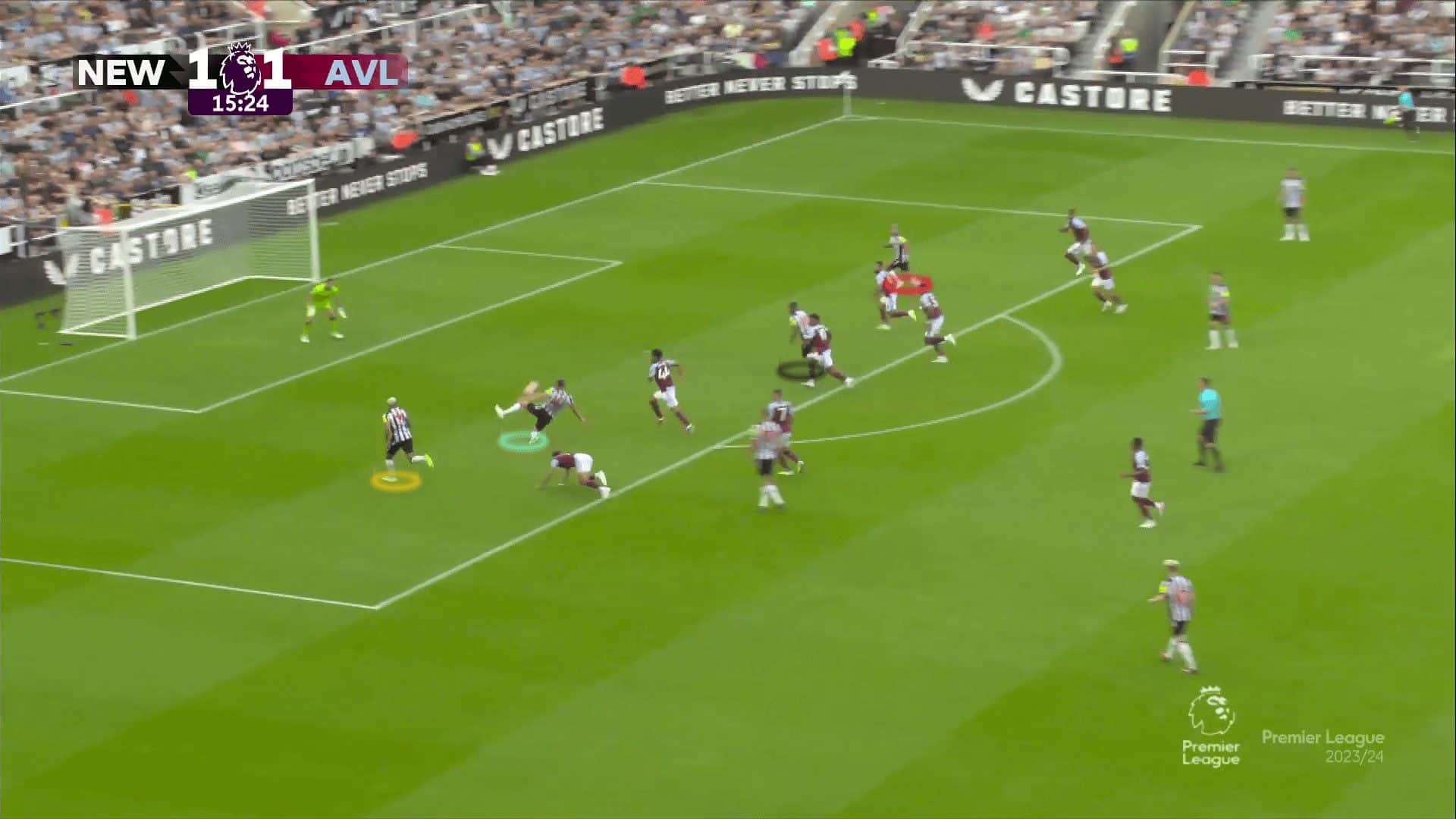
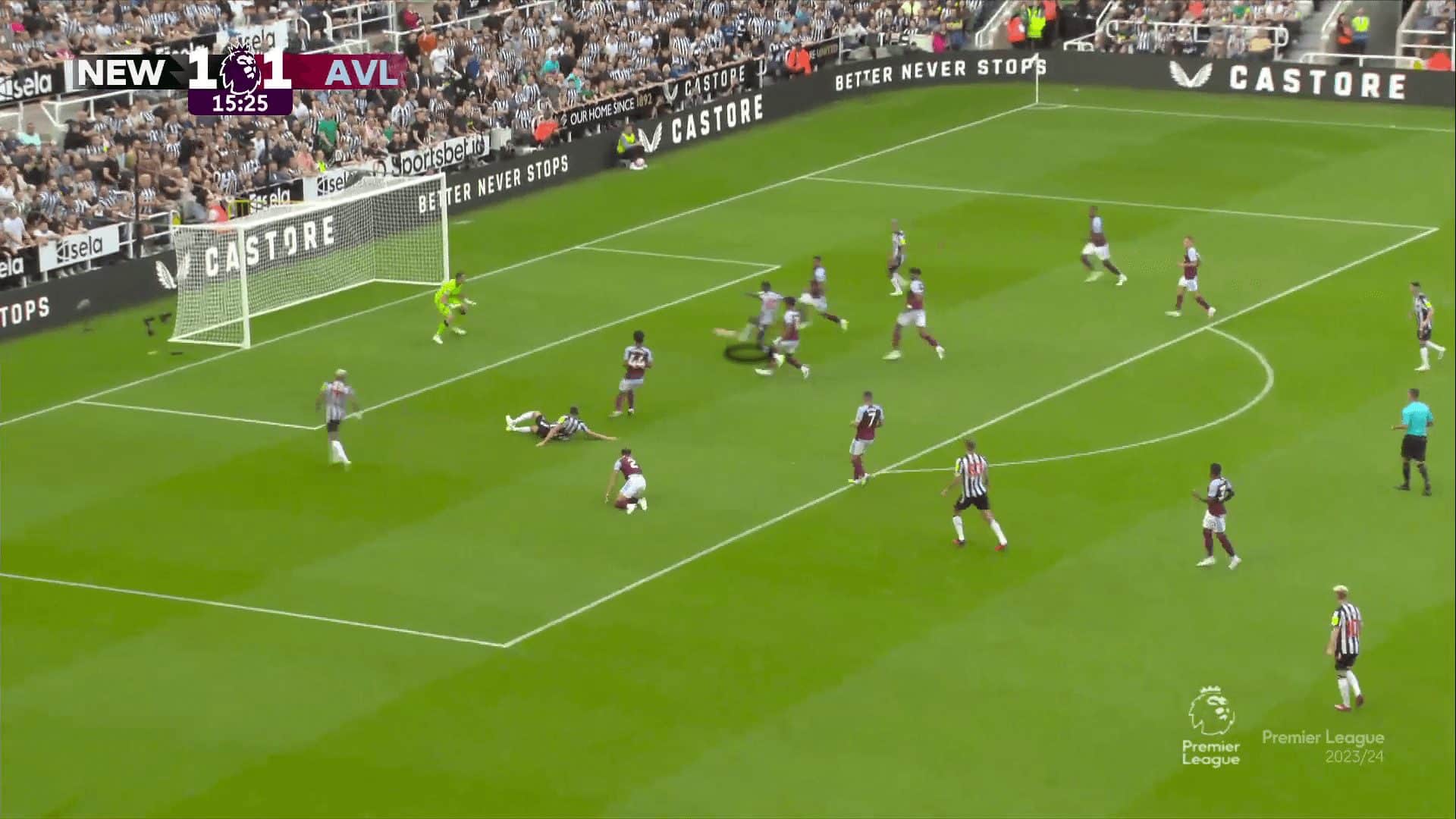
This misdirection can also be done by using two takers, as shown in the first photo below, where the taker passes the ball to another teammate. In contrast, the second taker goes behind the ball’s weak side. In contrast, two go to the two posts to receive the following cross — one starting in an offside position while the other comes deep after the last defender is fixed by an attacker, as shown in the second photo.
The cross isn’t perfect, so it goes to a far point, as in the third and fourth photos.
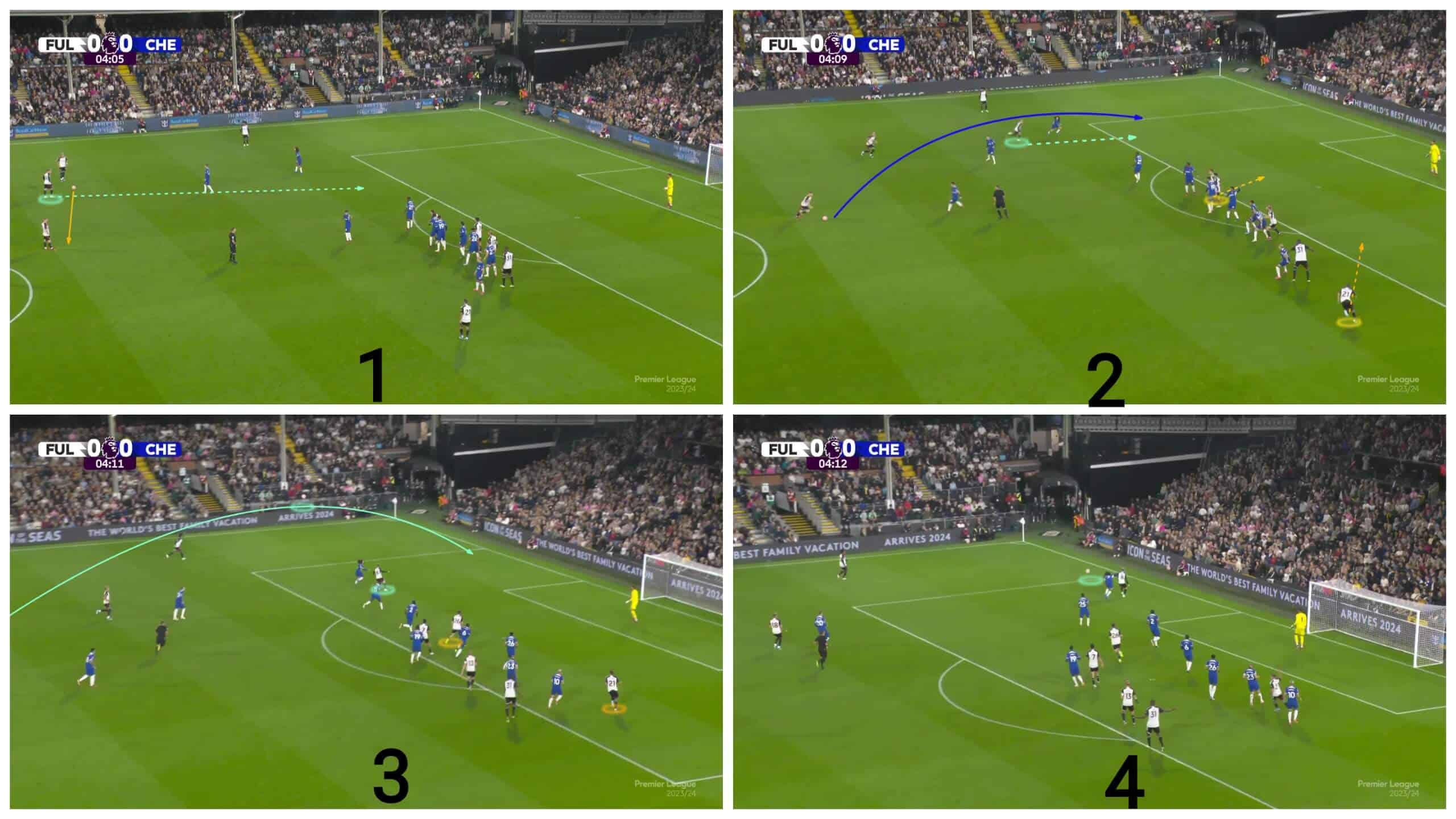
Conclusion
In this analysis, we have clarified the various purposes of short passes as part of free-kick tactics, whether the goal is to conclude with a shot or a cross.
In our set-piece analysis, we have also demonstrated that short passes preceding crosses offer several benefits, such as positioning skilful players in 1-v-1 situations, exploiting vacant space behind the defensive wall, or altering the direction of play to target areas that were previously difficult to reach and therefore less effectively defended by opponents. This strategy can lead to orientation problems for defenders and difficulty in maintaining the offside trap due to ball movement.

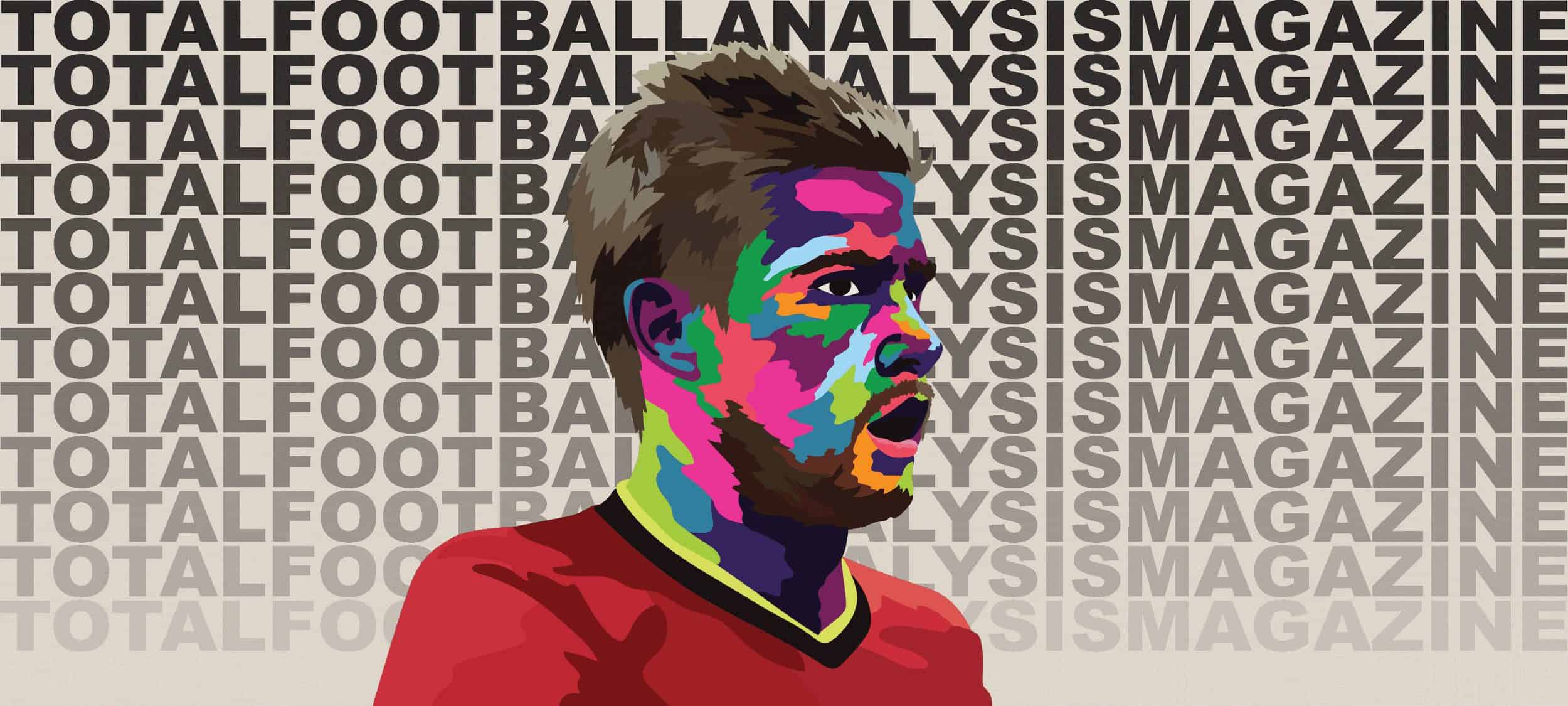




Comments